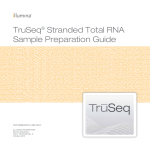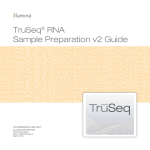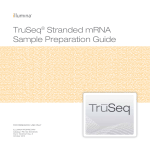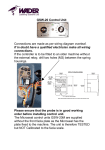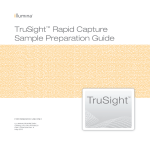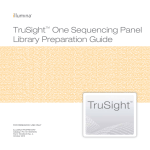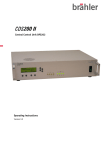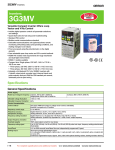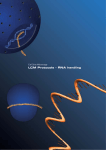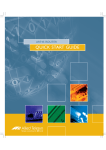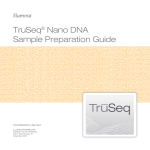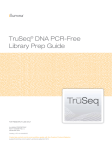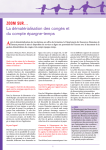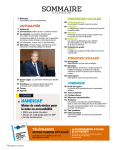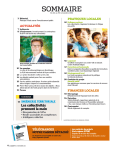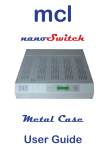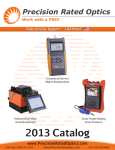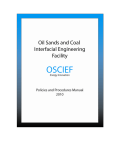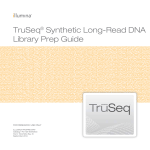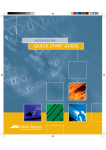Download TruSeq RNA Access Library Prep Guide - Support
Transcript
TruSeq® RNA Access Library Prep
Guide
FOR RESEARCH USE ONLY
ILLUMINA PROPRIETARY
RS-301-9001DOC
Part # 15049525 Rev. B
July 2014
This document and its contents are proprietary to Illumina, Inc. and its affiliates ("Illumina"), and are intended solely for the contractual use of
its customer in connection with the use of the product(s) described herein and for no other purpose. This document and its contents shall not
be used or distributed for any other purpose and/or otherwise communicated, disclosed, or reproduced in any way whatsoever without the
prior written consent of Illumina. Illumina does not convey any license under its patent, trademark, copyright, or common-law rights nor
similar rights of any third parties by this document.
The instructions in this document must be strictly and explicitly followed by qualified and properly trained personnel in order to ensure the
proper and safe use of the product(s) described herein. All of the contents of this document must be fully read and understood prior to using
such product(s).
FAILURE TO COMPLETELY READ AND EXPLICITLY FOLLOW ALL OF THE INSTRUCTIONS CONTAINED HEREIN MAY RESULT IN
DAMAGE TO THE PRODUCT(S), INJURY TO PERSONS, INCLUDING TO USERS OR OTHERS, AND DAMAGE TO OTHER PROPERTY.
ILLUMINA DOES NOT ASSUME ANY LIABILITY ARISING OUT OF THE IMPROPER USE OF THE PRODUCT(S) DESCRIBED HEREIN
(INCLUDING PARTS THEREOF OR SOFTWARE) OR ANY USE OF SUCH PRODUCT(S) OUTSIDE THE SCOPE OF THE EXPRESS
WRITTEN LICENSES OR PERMISSIONS GRANTED BY ILLUMINA IN CONNECTION WITH CUSTOMER'S ACQUISITION OF SUCH
PRODUCT(S).
FOR RESEARCH USE ONLY
© 2014 Illumina, Inc. All rights reserved.
Illumina, 24sure, BaseSpace, BeadArray, BlueFish, BlueFuse, BlueGnome, cBot, CSPro, CytoChip, DesignStudio, Epicentre, GAIIx,
Genetic Energy, Genome Analyzer, GenomeStudio, GoldenGate, HiScan, HiSeq, HiSeq X, Infinium, iScan, iSelect, ForenSeq, MiSeq,
MiSeqDx, MiSeq FGx, NeoPrep, Nextera, NextBio, NextSeq, Powered by Illumina, SeqMonitor, SureMDA, TruGenome, TruSeq,
TruSight, Understand Your Genome, UYG, VeraCode, verifi, VeriSeq, the pumpkin orange color, and the streaming bases design are
trademarks of Illumina, Inc. and/or its affiliate(s) in the U.S. and/or other countries. All other names, logos, and other trademarks are the
property of their respective owners.
Limited Use Label License: This product and its use are the subject of one or more issued and/or pending U.S. and foreign patent applications
owned by Max Planck Gesellschaft, exclusively licensed to New England Biolabs, Inc. and sublicensed to Illumina, Inc. The purchase of this
product from Illumina, Inc., its affiliates, or its authorized resellers and distributors conveys to the buyer the non-transferable right to use the
purchased amount of the product and components of the product by the buyer (whether the buyer is an academic or for profit entity). The
purchase of this product does not convey a license under any claims in the foregoing patents or patent applications directed to producing the
product. The buyer cannot sell or otherwise transfer this product or its components to a third party or otherwise use this product for the
following COMMERCIAL PURPOSES: (1) use of the product or its components in manufacturing; or (2) use of the product or its components
for therapeutic or prophylactic purposes in humans or animals.
Read Before Using this Product
This Product, and its use and disposition, is subject to the following terms and conditions. If Purchaser does not agree to these
terms and conditions then Purchaser is not authorized by Illumina to use this Product and Purchaser must not use this Product.
1
ii
Definitions. "Application Specific IP" means Illumina owned or controlled intellectual property rights that pertain to
this Product (and use thereof) only with regard to specific field(s) or specific application(s). Application Specific IP
excludes all Illumina owned or controlled intellectual property that cover aspects or features of this Product (or use
thereof) that are common to this Product in all possible applications and all possible fields of use (the "Core IP").
Application Specific IP and Core IP are separate, non-overlapping, subsets of all Illumina owned or controlled intellectual
property. By way of non-limiting example, Illumina intellectual property rights for specific diagnostic methods, for
specific forensic methods, or for specific nucleic acid biomarkers, sequences, or combinations of biomarkers or
sequences are examples of Application Specific IP. "Consumable(s)" means Illumina branded reagents and consumable
Part # 15049525 Rev. B
items that are intended by Illumina for use with, and are to be consumed through the use of, Hardware.
"Documentation" means Illumina's user manual for this Product, including without limitation, package inserts, and any
other documentation that accompany this Product or that are referenced by the Product or in the packaging for the Product
in effect on the date of shipment from Illumina. Documentation includes this document. "Hardware" means Illumina
branded instruments, accessories or peripherals. "Illumina" means Illumina, Inc. or an Illumina affiliate, as applicable.
"Product" means the product that this document accompanies (e.g., Hardware, Consumables, or Software). "Purchaser"
is the person or entity that rightfully and legally acquires this Product from Illumina or an Illumina authorized dealer.
"Software" means Illumina branded software (e.g., Hardware operating software, data analysis software). All Software is
licensed and not sold and may be subject to additional terms found in the Software's end user license agreement.
"Specifications" means Illumina's written specifications for this Product in effect on the date that the Product ships from
Illumina.
2
Research Use Only Rights. Subject to these terms and conditions and unless otherwise agreed upon in writing by an
officer of Illumina, Purchaser is granted only a non-exclusive, non-transferable, personal, non-sublicensable right under
Illumina's Core IP, in existence on the date that this Product ships from Illumina, solely to use this Product in Purchaser's
facility for Purchaser's internal research purposes (which includes research services provided to third parties) and solely
in accordance with this Product's Documentation, but specifically excluding any use that (a) would require rights or a
license from Illumina to Application Specific IP, (b) is a re-use of a previously used Consumable, (c) is the disassembling,
reverse-engineering, reverse-compiling, or reverse-assembling of this Product, (d) is the separation, extraction, or
isolation of components of this Product or other unauthorized analysis of this Product, (e) gains access to or determines
the methods of operation of this Product, (f) is the use of non-Illumina reagent/consumables with Illumina's Hardware
(does not apply if the Specifications or Documentation state otherwise), or (g) is the transfer to a third-party of, or sublicensing of, Software or any third-party software. All Software, whether provided separately, installed on, or embedded
in a Product, is licensed to Purchaser and not sold. Except as expressly stated in this Section, no right or license under
any of Illumina's intellectual property rights is or are granted expressly, by implication, or by estoppel.
Purchaser is solely responsible for determining whether Purchaser has all intellectual property rights that are
necessary for Purchaser's intended uses of this Product, including without limitation, any rights from third
parties or rights to Application Specific IP. Illumina makes no guarantee or warranty that purchaser's specific
intended uses will not infringe the intellectual property rights of a third party or Application Specific IP.
3
Regulatory. This Product has not been approved, cleared, or licensed by the United States Food and Drug
Administration or any other regulatory entity whether foreign or domestic for any specific intended use, whether
research, commercial, diagnostic, or otherwise. This Product is labeled For Research Use Only. Purchaser must ensure it
has any regulatory approvals that are necessary for Purchaser's intended uses of this Product.
4
Unauthorized Uses. Purchaser agrees: (a) to use each Consumable only one time, and (b) to use only Illumina
consumables/reagents with Illumina Hardware. The limitations in (a)-(b) do not apply if the Documentation or
Specifications for this Product state otherwise. Purchaser agrees not to, nor authorize any third party to, engage in any of
the following activities: (i) disassemble, reverse-engineer, reverse-compile, or reverse-assemble the Product, (ii) separate,
extract, or isolate components of this Product or subject this Product or components thereof to any analysis not expressly
authorized in this Product's Documentation, (iii) gain access to or attempt to determine the methods of operation of this
Product, or (iv) transfer to a third-party, or grant a sublicense, to any Software or any third-party software. Purchaser
further agrees that the contents of and methods of operation of this Product are proprietary to Illumina and this Product
contains or embodies trade secrets of Illumina. The conditions and restrictions found in these terms and conditions are
bargained for conditions of sale and therefore control the sale of and use of this Product by Purchaser.
5
Limited Liability. TO THE EXTENT PERMITTED BY LAW, IN NO EVENT SHALL ILLUMINA OR ITS
SUPPLIERS BE LIABLE TO PURCHASER OR ANY THIRD PARTY FOR COSTS OF PROCUREMENT OF
SUBSTITUTE PRODUCTS OR SERVICES, LOST PROFITS, DATA OR BUSINESS, OR FOR ANY INDIRECT,
SPECIAL, INCIDENTAL, EXEMPLARY, CONSEQUENTIAL, OR PUNITIVE DAMAGES OF ANY KIND ARISING
TruSeq RNA Access Library Prep Guide
iii
OUT OF OR IN CONNECTION WITH, WITHOUT LIMITATION, THE SALE OF THIS PRODUCT, ITS USE,
ILLUMINA'S PERFORMANCE HEREUNDER OR ANY OF THESE TERMS AND CONDITIONS, HOWEVER
ARISING OR CAUSED AND ON ANY THEORY OF LIABILITY (WHETHER IN CONTRACT, TORT
(INCLUDING NEGLIGENCE), STRICT LIABILITY OR OTHERWISE).
6
ILLUMINA'S TOTAL AND CUMULATIVE LIABILITY TO PURCHASER OR ANY THIRD PARTY ARISING OUT
OF OR IN CONNECTION WITH THESE TERMS AND CONDITIONS, INCLUDING WITHOUT LIMITATION,
THIS PRODUCT (INCLUDING USE THEREOF) AND ILLUMINA'S PERFORMANCE HEREUNDER, WHETHER
IN CONTRACT, TORT (INCLUDING NEGLIGENCE), STRICT LIABILITY OR OTHERWISE, SHALL IN NO
EVENT EXCEED THE AMOUNT PAID TO ILLUMINA FOR THIS PRODUCT.
7
Limitations on Illumina Provided Warranties. TO THE EXTENT PERMITTED BY LAW AND SUBJECT TO THE
EXPRESS PRODUCT WARRANTY MADE HEREIN ILLUMINA MAKES NO (AND EXPRESSLY DISCLAIMS
ALL) WARRANTIES, EXPRESS, IMPLIED OR STATUTORY, WITH RESPECT TO THIS PRODUCT,
INCLUDING WITHOUT LIMITATION, ANY IMPLIED WARRANTY OF MERCHANTABILITY, FITNESS FOR A
PARTICULAR PURPOSE, NONINFRINGEMENT, OR ARISING FROM COURSE OF PERFORMANCE,
DEALING, USAGE OR TRADE. WITHOUT LIMITING THE GENERALITY OF THE FOREGOING, ILLUMINA
MAKES NO CLAIM, REPRESENTATION, OR WARRANTY OF ANY KIND AS TO THE UTILITY OF THIS
PRODUCT FOR PURCHASER'S INTENDED USES.
8
Product Warranty. All warranties are personal to the Purchaser and may not be transferred or assigned to a third-party,
including an affiliate of Purchaser. All warranties are facility specific and do not transfer if the Product is moved to
another facility of Purchaser, unless Illumina conducts such move.
a
Warranty for Consumables. Illumina warrants that Consumables, other than custom Consumables, will conform to
their Specifications until the later of (i) 3 months from the date of shipment from Illumina, and (ii) any expiration
date or the end of the shelf-life pre-printed on such Consumable by Illumina, but in no event later than 12 months
from the date of shipment. With respect to custom Consumables (i.e., Consumables made to specifications or
designs made by Purchaser or provided to Illumina by, or on behalf of, Purchaser), Illumina only warrants that the
custom Consumables will be made and tested in accordance with Illumina's standard manufacturing and quality
control processes. Illumina makes no warranty that custom Consumables will work as intended by Purchaser or for
Purchaser's intended uses.
b
Warranty for Hardware. Illumina warrants that Hardware, other than Upgraded Components, will conform to its
Specifications for a period of 12 months after its shipment date from Illumina unless the Hardware includes Illumina
provided installation in which case the warranty period begins on the date of installation or 30 days after the date it
was delivered, whichever occurs first ("Base Hardware Warranty"). "Upgraded Components" means Illumina
provided components, modifications, or enhancements to Hardware that was previously acquired by Purchaser.
Illumina warrants that Upgraded Components will conform to their Specifications for a period of 90 days from the
date the Upgraded Components are installed. Upgraded Components do not extend the warranty for the Hardware
unless the upgrade was conducted by Illumina at Illumina's facilities in which case the upgraded Hardware shipped
to Purchaser comes with a Base Hardware Warranty.
c
Exclusions from Warranty Coverage. The foregoing warranties do not apply to the extent a non-conformance is
due to (i) abuse, misuse, neglect, negligence, accident, improper storage, or use contrary to the Documentation or
Specifications, (ii) improper handling, installation, maintenance, or repair (other than if performed by Illumina's
personnel), (iii) unauthorized alterations, (iv) Force Majeure events, or (v) use with a third party's good not provided
by Illumina (unless the Product's Documentation or Specifications expressly state such third party's good is for use
with the Product).
d
Procedure for Warranty Coverage. In order to be eligible for repair or replacement under this warranty Purchaser
must (i) promptly contact Illumina's support department to report the non-conformance, (ii) cooperate with Illumina
in confirming or diagnosing the non-conformance, and (iii) return this Product, transportation charges prepaid to
iv
Part # 15049525 Rev. B
e
f
9
Illumina following Illumina's instructions or, if agreed by Illumina and Purchaser, grant Illumina's authorized repair
personnel access to this Product in order to confirm the non-conformance and make repairs.
Sole Remedy under Warranty. Illumina will, at its option, repair or replace non-conforming Product that it
confirms is covered by this warranty. Repaired or replaced Consumables come with a 30-day warranty. Hardware
may be repaired or replaced with functionally equivalent, reconditioned, or new Hardware or components (if only a
component of Hardware is non-conforming). If the Hardware is replaced in its entirety, the warranty period for the
replacement is 90 days from the date of shipment or the remaining period on the original Hardware warranty,
whichever is shorter. If only a component is being repaired or replaced, the warranty period for such component is
90 days from the date of shipment or the remaining period on the original Hardware warranty, whichever ends later.
The preceding states Purchaser's sole remedy and Illumina's sole obligations under the warranty provided
hereunder.
Third-Party Goods and Warranty. Illumina has no warranty obligations with respect to any goods originating
from a third party and supplied to Purchaser hereunder. Third-party goods are those that are labeled or branded
with a third-party's name. The warranty for third-party goods, if any, is provided by the original manufacturer.
Upon written request Illumina will attempt to pass through any such warranty to Purchaser.
Indemnification.
a
Infringement Indemnification by Illumina. Subject to these terms and conditions, including without limitation,
the Exclusions to Illumina's Indemnification Obligations (Section 9(b) below), the Conditions to Indemnification
Obligations (Section 9(d) below), Illumina shall (i) defend, indemnify and hold harmless Purchaser against any
third-party claim or action alleging that this Product when used for research use purposes, in accordance with these
terms and conditions, and in accordance with this Product's Documentation and Specifications infringes the valid
and enforceable intellectual property rights of a third party, and (ii) pay all settlements entered into, and all final
judgments and costs (including reasonable attorneys' fees) awarded against Purchaser in connection with such
infringement claim. If this Product or any part thereof, becomes, or in Illumina's opinion may become, the subject of
an infringement claim, Illumina shall have the right, at its option, to (A) procure for Purchaser the right to continue
using this Product, (B) modify or replace this Product with a substantially equivalent non-infringing substitute, or
(C) require the return of this Product and terminate the rights, license, and any other permissions provided to
Purchaser with respect this Product and refund to Purchaser the depreciated value (as shown in Purchaser's official
records) of the returned Product at the time of such return; provided that, no refund will be given for used-up or
expired Consumables. This Section states the entire liability of Illumina for any infringement of third party
intellectual property rights.
b
Exclusions to Illumina Indemnification Obligations. Illumina has no obligation to defend, indemnify or hold
harmless Purchaser for any Illumina Infringement Claim to the extent such infringement arises from: (i) the use of
this Product in any manner or for any purpose outside the scope of research use purposes, (ii) the use of this Product
in any manner not in accordance with its Specifications, its Documentation, the rights expressly granted to Purchaser
hereunder, or any breach by Purchaser of these terms and conditions, (iii) the use of this Product in combination
with any other products, materials, or services not supplied by Illumina, (iv) the use of this Product to perform any
assay or other process not supplied by Illumina, or (v) Illumina's compliance with specifications or instructions for
this Product furnished by, or on behalf of, Purchaser (each of (i) – (v), is referred to as an "Excluded Claim").
c
Indemnification by Purchaser. Purchaser shall defend, indemnify and hold harmless Illumina, its affiliates, their
non-affiliate collaborators and development partners that contributed to the development of this Product, and their
respective officers, directors, representatives and employees against any claims, liabilities, damages, fines, penalties,
causes of action, and losses of any and every kind, including without limitation, personal injury or death claims, and
infringement of a third party's intellectual property rights, resulting from, relating to, or arising out of (i) Purchaser's
breach of any of these terms and conditions, (ii) Purchaser's use of this Product outside of the scope of research use
purposes, (iii) any use of this Product not in accordance with this Product's Specifications or Documentation, or (iv)
any Excluded Claim.
TruSeq RNA Access Library Prep Guide
v
d
e
vi
Conditions to Indemnification Obligations. The parties' indemnification obligations are conditioned upon the
party seeking indemnification (i) promptly notifying the other party in writing of such claim or action, (ii) giving the
other party exclusive control and authority over the defense and settlement of such claim or action, (iii) not admitting
infringement of any intellectual property right without prior written consent of the other party, (iv) not entering into
any settlement or compromise of any such claim or action without the other party's prior written consent, and (v)
providing reasonable assistance to the other party in the defense of the claim or action; provided that, the party
reimburses the indemnified party for its reasonable out-of-pocket expenses incurred in providing such assistance.
Third-Party Goods and Indemnification. Illumina has no indemnification obligations with respect to any goods
originating from a third party and supplied to Purchaser. Third-party goods are those that are labeled or branded
with a third-party's name. Purchaser's indemnification rights, if any, with respect to third party goods shall be
pursuant to the original manufacturer's or licensor's indemnity. Upon written request Illumina will attempt to pass
through such indemnity, if any, to Purchaser.
Part # 15049525 Rev. B
Revision History
Part #
Revision
Date
15049525
B
July 2014
15049525
A
April 2014
TruSeq RNA Access Library Prep Guide
Description of Change
• Removed instructions regarding barcodes and replaced with
instructions to label plate with a pen
• Modified the following plate names:
• NEH1 changed to RAH1 (RNA Access Hyb 1)
• NEW1 changed to RAW1 (RNA Access Wash 1)
• NEH2 changed to RAH2 (RNA Access Hyb 2)
• NEW2 changed to RAW2 (RNA Access Wash 2)
• NEC1 changed to RAC1 (RNA Access Clean Up 1)
• NEA changed to RAA (RNA Access Amplification)
• NEC2 changed to RAC2 (RNA Access Clean Up 2)
• NEL changed to RAL (RNA Access Library)
• Replaced DEPC-treated water with nuclease-free water to Fragment
RNA.
• To Clean Up ALP
• Changed CAP plate Resuspension Buffer volume from 17.5 µl to
22.5 µl
• Changed final supernatant transfer volume from 15 µl to 20 µl
• Included initial 98°C for 30 seconds setting in Preparation steps for
First PCR Amplification.
• Added AMPure XP beads to Consumables and Equipment
• Removed distilled water and PCR-grade water from Consumables
and Equipment
Initial Release
vii
viii
Part # 15049525 Rev. B
Table of Contents
Revision History
Table of Contents
Chapter 1 Overview
Introduction
RNA Input Recommendations
Additional Resources
Chapter 2 Protocol
vii
ix
1
2
3
7
9
Introduction
Library Prep Workflow
Prepare Adapter Setup
Fragment RNA
Synthesize First Strand cDNA
Synthesize Second Strand cDNA
Adenylate 3' Ends
Ligate Adapters
First PCR Amplification
Validate Library
First Hybridization
First Capture
Second Hybridization
Second Capture
Capture Sample Clean Up
Second PCR Amplification
Second PCR Clean Up
Validate Library
10
11
12
13
17
20
24
26
32
37
39
43
48
50
54
57
60
63
Appendix A Supporting Information
65
Introduction
Acronyms
Kit Contents
Consumables and Equipment
TruSeq RNA Access Library Prep Kit Indexed Adapter Sequences
TruSeq RNA Access Library Prep Guide
66
67
70
76
82
ix
Technical Assistance
x
85
Part # 15049525 Rev. B
Chapter 1 Overview
Introduction
RNA Input Recommendations
Additional Resources
TruSeq RNA Access Library Prep Guide
2
3
7
1
Chapter 1
Overview
Overview
Introduction
This protocol explains how to convert total RNA into a library of template molecules of
known strand origin, then capture the coding regions of the transcriptome using the
reagents provided in Illumina® TruSeq® RNA Access Library Prep kits. The resulting library
is suitable for subsequent cluster generation and sequencing.
The RNA is fragmented into small pieces using divalent cations under elevated
temperature. cDNA is generated from the cleaved RNA fragments using random priming
during first and second strand synthesis and sequencing adapters are ligated to the
resulting double-stranded cDNA fragments. The coding regions of the transcriptome are
then captured from this library using sequence-specific probes to create the final library.
This library prep protocol offers:
} High data quality even from degraded or FFPE-derived RNA samples
} Input requirement as low as 10 ng for fresh/frozen samples and 20 ng for FFPE
samples
} Uniform capture of the coding transcriptome, reducing sequencing requirement while
maintaining discovery power
} Up to 24 unique indexes and 4-plex pre-enrichment pooling for the most efficient use of
your sequencing read budget
} Strand information on RNA transcripts
} High throughput, automation-friendly procedures
2
Part # 15049525 Rev. B
It is important to follow the TruSeq RNA Access Library Prep input recommendations.
Total RNA Input
} This protocol is optimized for 10–100 ng of human total RNA.
• Lower amounts might result in inefficient ligation and low yield.
} The protocol has been tested using 10 ng of high-quality universal human reference
total RNA as input.
• Use of RNA from other tissues or qualities might require further optimization
regarding the initial input amount.
} It is important to know the quality of the RNA starting material. The fragmentation
conditions were optimized for high-quality RNA. The following figure shows a
Universal Human Reference (UHR) starting RNA Bioanalyzer trace.
Figure 1 Starting RNA Bioanalyzer Trace
} Degraded or FFPE RNAs are shorter than full length RNA.
• RNA that has DNA contamination results in an underestimation of the amount of
RNA used.
TruSeq RNA Access Library Prep Guide
3
RNA Input Recommendations
RNA Input Recommendations
Overview
• If starting with FFPE RNA, the sample input amount is based on sample quality.
Illumina recommends using the percentage of RNA fragments > 200 nt fragment
distribution value (DV200) as a reliable determinant of FFPE RNA quality.
Table 1 FFPE RNA Input Recommendations
Quality
DV200
Input Requirement
Per Reaction
High
> 70%
20 ng
Medium
50–70%
20–40 ng
Low
30–50%
40–100 ng
Too Degraded
< 30%
Not recommended
— For successful library prep, Illumina recommends using an RNA isolation
method that includes a reverse-crosslinking step and DNase1 treatment, such
as the QIAGEN RNeasy FFPE Kit or QIAGEN AllPrep DNA/RNA FFPE Kit.
— Illumina determines FFPE RNA concentration by Nanodrop.
— For best performance on samples close to edge of a quality classification, err
towards the higher end of the input recommendation.
NOTE
For more information, see the Evaluating RNA Quality from FFPE Samples tech note
for TruSeq RNA Access Library Prep. See Additional Resources on page 7 for
information on how to download the tech note from the Illumina website.
4
Part # 15049525 Rev. B
Figure 2 Example: High Quality FFPE (DV200 = 77%)
Figure 3 Example: Medium Quality FFPE (DV200 = 55%)
TruSeq RNA Access Library Prep Guide
5
RNA Input Recommendations
• The following are examples of high, medium, and low quality FFPE traces and a
trace of FFPE quality that is not recommended for use for TruSeq RNA Access
Library Prep.
Overview
Figure 4 Example: Low Quality FFPE (DV200 = 30%)
Figure 5 Example: FFPE Quality Not Recommended for Use (DV200 = 8%)
Positive Control
Illumina recommends using Agilent Technologies Human UHR total RNA
(catalog # 740000) as a positive control sample for this protocol.
6
Part # 15049525 Rev. B
The following resources are available for TruSeq RNA Access Library Prep protocol
guidance and sample tracking. Access these and other resources on the Illumina website at
support.illumina.com/sequencing/kits.ilmn. Then, select TruSeq RNA Access Library Prep
Kit Support.
Resource
Description
Training
Illustrates elements of the TruSeq RNA Access Library Prep
process. Viewing these videos is recommended for new and
less experienced users before starting library prep.
Click Training on TruSeq RNA Access Library Prep
Kit Support
Best Practices
Provides best practices specific to this protocol. Review these
best practices before starting library prep. Topics include:
• Handling Liquids
• Handling Master Mix Reagents
• Handling Magnetic Beads
• Avoiding Cross-Contamination
• Potential DNA Contaminants
• Temperature Considerations
• Equipment
Click Best Practices on TruSeq RNA Access Library Prep
Kit Support
TruSeq RNA Access Library
Prep Experienced User Card
and Lab Tracking Form
(part # 15049526)
Provides protocol instructions, but with less detail than what is
provided in this user guide. New or less experienced users
are advised to follow this user guide and not the EUC and
LTF.
Click Documentation & Literature on TruSeq RNA Access
Library Prep Kit Support
Evaluating RNA Quality from
FFPE Samples tech note
Provides effectivity profiles for FFPE RNA.
Click Documentation & Literature on TruSeq RNA Access
Library Prep Kit Support
TruSeq RNA Access Library Prep Guide
7
Additional Resources
Additional Resources
Overview
8
Resource
Description
TruSeq Sample Preparation
Pooling Guide (part # 15042173)
Provides TruSeq pooling guidelines for library prep. Review
this guide before beginning library preparation.
Click Documentation & Literature on TruSeq RNA Access
Library Prep Kit Support
Sequencing Library qPCR
Quantification Guide (part #
11322363)
Describes a qPCR method for quantifying sequencing by
synthesis (SBS) libraries generated using the Illumina library
prep protocols.
Click Documentation & Literature on TruSeq RNA Access
Library Prep Kit Support
Illumina Experiment Manager
(IEM)
Enables you to create and edit appropriate sample sheets for
Illumina sequencing systems and analysis software and record
parameters for your sample plate.
To download the software, click Downloads on TruSeq RNA
Access Library Prep Kit Support
To download the documentation, click Documentation &
Literature on TruSeq RNA Access Library Prep Kit Support
BaseSpace®
Sequencing data analysis tool that also enables you to
organize samples, libraries, pools, and run in a single
environment.
For more information on BaseSpace see,
support.illumina.com/sequencing/sequencing_
software/basespace.ilmn
Part # 15049525 Rev. B
Chapter 2 Protocol
Introduction
Library Prep Workflow
Prepare Adapter Setup
Fragment RNA
Synthesize First Strand cDNA
Synthesize Second Strand cDNA
Adenylate 3' Ends
Ligate Adapters
First PCR Amplification
Validate Library
First Hybridization
First Capture
Second Hybridization
Second Capture
Capture Sample Clean Up
Second PCR Amplification
Second PCR Clean Up
Validate Library
TruSeq RNA Access Library Prep Guide
10
11
12
13
17
20
24
26
32
37
39
43
48
50
54
57
60
63
9
Chapter 2
Protocol
Protocol
Introduction
This chapter describes the TruSeq RNA Access Library Prep protocol.
} Review Best Practices before proceeding. See Additional Resources on page 7 for
information on how to access TruSeq RNA Access Library Prep Best Practices on the
Illumina website.
} Follow the protocols in the order shown, using the specified volumes and incubation
parameters.
} If you are pooling, record information about your samples before beginning library prep
for later use in data analysis.
• Use IEM to create and edit sample sheets for Illumina sequencing systems and
analysis software. See Additional Resources on page 7 for information on how to
download IEM software and documentation from the Illumina website.
• TruSeq Sample Preparation Pooling Guide (part # 15042173)—See Additional Resources
on page 7 for information on how to download the guide from the Illumina
website.
} Review Appendix A Supporting Information to confirm your kit contents and make
sure that you have obtained all of the requisite equipment and consumables.
10
Part # 15049525 Rev. B
The following illustrates the processes of the TruSeq RNA Access Library Prep protocol to
prepare templates using 24 indexed adapter tubes.
Figure 6 TruSeq RNA Access Library Prep Workflow
TruSeq RNA Access Library Prep Guide
11
Library Prep Workflow
Library Prep Workflow
Protocol
Prepare Adapter Setup
Use IEM or BaseSpace to record information about your samples before beginning library
preparation.
} Do one of the following:
• Use IEM to create and edit sample sheets for Illumina sequencing systems and
analysis software. See Additional Resources on page 7 for information on how to
download IEM software and documentation from the Illumina website.
• Use BaseSpace to organize samples, libraries, pools, and a run for Illumina
sequencing systems and analysis software. See Additional Resources on page 7 for
information on how to access BaseSpace or download BaseSpace documentation
from the Illumina website.
} Review planning steps in the TruSeq Sample Preparation Pooling Guide (part # 15042173).
See Additional Resources on page 7 for information on how to download the guide from
the Illumina website.
Illumina recommends arranging samples that will be combined into a common pool in the
same row. Include a common index in each column. This arrangement facilitates pipetting
operations when dispensing indexed adapters and pooling indexed libraries later in the
protocol.
12
Part # 15049525 Rev. B
This process fragments and primes RNA for cDNA synthesis.
NOTE
If starting with FFPE RNA, the sample input amount is based on sample quality. Illumina
recommends using the percentage of RNA fragments > 200 nt DV200 as a reliable
determinant of FFPE RNA quality.
WARNING
If starting with FFPE RNA, do not perform the Incubate 1 DFP steps in this procedure.
Table 2 FFPE RNA Input Recommendations
Quality
DV200
Input Requirement
Per Reaction
High
> 70%
20 ng
Medium
50–70%
20–40 ng
Low
30–50%
40–100 ng
Too Degraded
< 30%
Not recommended
NOTE
For more information, see the Evaluating RNA Quality from FFPE Samples tech note
for TruSeq RNA Access Library Prep. See Additional Resources on page 7 for
information on how to download the tech note from the Illumina website.
TruSeq RNA Access Library Prep Guide
13
Fragment RNA
Fragment RNA
Protocol
Consumables
14
Item
Quantity
Storage
Supplied By
Elute, Prime, Fragment High
Mix (EPH)
1 tube per 48 reactions
-25°C to -15°C
Illumina
Resuspension Buffer (RSB)
1 tube
-25°C to -15°C
Illumina
96-well HSP plate
1
15°C to 30°C
User
Microseal ‘B’ adhesive seal
1
15°C to 30°C
User
Total RNA
10 ng fresh/frozen RNA
per reaction
or
20–100 ng
FFPE RNA per reaction
(see Table 2)
15°C to 30°C
User
RNase/DNase-free eight-tube
strips and caps
(if using multichannel
pipettes)
1
15°C to 30°C
User
RNase/DNase-free reagent
reservoirs
(if using multichannel
pipettes)
1
15°C to 30°C
User
Nuclease-free ultra pure
water
Enough to dilute each
total RNA sample to a
final volume of 8.5 µl
15°C to 30°C
User
Part # 15049525 Rev. B
} Remove the following from -25°C to -15°C storage and thaw them at room temperature:
• Elute, Prime, Fragment High Mix
• Resuspension Buffer
NOTE
The Resuspension Buffer can be stored at 2°C to 8°C after the initial thaw.
} Pre-program the thermal cycler with the following program and save as Elution 2 Frag - Prime:
• Choose the pre-heat lid option and set to 100°C
• 94°C for 8 minutes, 4°C hold
} Set the centrifuge to 15°C to 25°C, if refrigerated.
} Label a new 96-well HSP plate DFP (Depleted RNA Fragmentation Plate) with a
smudge resistant pen.
Make DFP
1
Dilute total RNA with nuclease-free ultra pure water to a final volume of 8.5 µl in each
well of the new 96-well HSP plate labeled DFP.
2
Add 8.5 µl Elute, Prime, Fragment High Mix to each well of the DFP plate. Mix
thoroughly as follows:
a Seal the DFP plate with a Microseal ‘B’ adhesive seal.
b Shake the DFP plate on a microplate shaker continuously at 1600 rpm for
20 seconds.
3
Return the Elute, Prime, Fragment High Mix to -25°C to -15°C storage.
TruSeq RNA Access Library Prep Guide
15
Fragment RNA
Preparation
Protocol
Incubate 1 DFP
WARNING
If starting with FFPE RNA, do not perform this incubation procedure. Proceed immediately
to Synthesize First Strand cDNA on page 17.
16
1
Place the sealed DFP plate on the pre-programmed thermal cycler. Close the lid and
select Elution 2 - Frag - Prime to fragment and prime the RNA.
a Choose the pre-heat lid option and set to 100°C
b 94°C for 8 minutes
c Hold at 4°C
2
Remove the DFP plate from the thermal cycler when it reaches 4°C and centrifuge
briefly.
3
Proceed immediately to Synthesize First Strand cDNA on page 17.
Part # 15049525 Rev. B
This process reverse transcribes the cleaved RNA fragments that were primed with random
hexamers into first strand cDNA using reverse transcriptase. The addition of actinomycin
D to the First Stand Synthesis Act D mix (FSA) prevents spurious DNA-dependent
synthesis, while allowing RNA-dependent synthesis, improving strand specificity.
Consumables
Item
Quantity
Storage
Supplied By
First Strand Synthesis Act D
Mix (FSA)
1 tube
-25°C to -15°C
Illumina
Microseal ‘B’ adhesive seal
1
15°C to 30°C
User
RNase/DNase-free eight-tube
strips and caps
(if using multichannel pipettes)
1
15°C to 30°C
User
RNase/DNase-free reagent
reservoirs
(if using multichannel pipettes)
1
15°C to 30°C
User
SuperScript II Reverse
Transcriptase
1 tube
-25°C to -15°C
User
WARNING
First Strand Synthesis Act D Mix contains actinomycin D, a toxin. Personal injury can occur
through inhalation, ingestion, skin contact, and eye contact. Dispose of containers and any
unused contents in accordance with the governmental safety standards for your region.
Refer to the safety data sheet (SDS) for detailed environmental, health, and safety
information. SDSs are available on the Illumina website at www.illumina.com/msds.
Preparation
} Remove one tube of First Strand Synthesis Act D Mix from -25°C to -15°C storage and
thaw it at room temperature.
TruSeq RNA Access Library Prep Guide
17
Synthesize First Strand cDNA
Synthesize First Strand cDNA
Protocol
} Pre-program the thermal cycler with the following program and save as Synthesize 1st
Strand:
• Choose the pre-heat lid option and set to 100°C
• 25°C for 10 minutes
• 42°C for 15 minutes
• 70°C for 15 minutes
• Hold at 4°C
} Make sure that the microplate shaker is properly calibrated to 1000 rpm using a
stroboscope.
NOTE
The First Strand Synthesis Mix Act D with SuperScript II added is stable to additional
freeze-thaw cycles and can be used for subsequent experiments. If more than six freezethaw cycles are anticipated, divide the First Strand Synthesis Mix Act D and SuperScript
II mix into smaller aliquots and store at -25°C to -15°C.
Add FSA
18
1
Remove the adhesive seal from the DFP plate.
2
Centrifuge the thawed First Strand Synthesis Mix Act D tube at 600 × g for 5 seconds.
3
Add 50 µl SuperScript II to the First Strand Synthesis Act D Mix tube. Mix gently, but
thoroughly and centrifuge briefly. If you are not using the entire contents of the First
Strand Synthesis Act D Mix tube, add SuperScript II at a ratio of 1 µl SuperScript II for
each 9 µl First Strand Synthesis Act D Mix.
Label the First Strand Synthesis Mix Act D tube to indicate that the SuperScript II has
been added.
4
Add 8 µl of First Strand Synthesis Mix Act D and SuperScript II mix to each well of the
DFP plate. Mix thoroughly as follows:
a Seal the DFP plate with a Microseal ‘B’ adhesive seal.
b Shake the DFP plate on a microplate shaker continuously at 1600 rpm for
20 seconds.
5
Return the First Strand Synthesis Mix Act D tube to -25°C to -15°C storage immediately
after use.
Part # 15049525 Rev. B
1
Place the sealed DFP plate on the pre-programmed thermal cycler. Close the lid and
select Synthesize 1st Strand.
a Choose the pre-heat lid option and set to 100°C
b 25°C for 10 minutes
c 42°C for 15 minutes
d 70°C for 15 minutes
e Hold at 4°C
2
When the thermal cycler reaches 4°C, remove the DFP plate from the thermal cycler
and proceed immediately to Synthesize Second Strand cDNA on page 20.
TruSeq RNA Access Library Prep Guide
19
Synthesize First Strand cDNA
Incubate 2 DFP
Protocol
Synthesize Second Strand cDNA
This process removes the RNA template and synthesizes a replacement strand,
incorporating dUTP in place of dTTP to generate ds cDNA. The incorporation of dUTP
quenches the second strand during amplification, because the polymerase does not
incorporate past this nucleotide. AMPure XP beads are used to separate the ds cDNA from
the second strand reaction mix. At the end of this process, you have blunt-ended cDNA.
Consumables
Item
Quantity
Storage
Supplied By
Resuspension Buffer (RSB)
1 tube
2°C to 8°C
Illumina
Second Strand Marking Master
Mix (SMM)
1 tube per 48
reactions
-25°C to -15°C
Illumina
96-well MIDI plates
2
15°C to 30°C
User
AMPure XP beads
90 µl per sample
2°C to 8°C
User
Freshly prepared 80% ethanol
(EtOH)
400 µl per sample
15°C to 30°C
User
Microseal ‘B’ adhesive seals
4
15°C to 30°C
User
RNase/DNase-free eight-tube
strips and caps
(if using multichannel pipettes)
5
15°C to 30°C
User
RNase/DNase-free reagent
reservoirs
(if using multichannel pipettes)
5
15°C to 30°C
User
Preparation
} Remove the Second Strand Marking Master Mix from -25°C to -15°C storage and thaw
it at room temperature.
} Remove the Resuspension Buffer from 2°C to 8°C storage and bring it to room
temperature.
20
Part # 15049525 Rev. B
Add SMM
1
Remove the adhesive seal from the DFP plate.
2
Add 5 µl of Resuspension Buffer to each well of the DFP plate.
3
Centrifuge the thawed Second Strand Marking Master Mix at 600 × g for 5 seconds.
4
Add 20 µl of thawed Second Strand Marking Master Mix to each well of the DFP plate.
Mix thoroughly as follows:
a Seal the DFP plate with a Microseal ‘B’ adhesive seal.
b Shake the DFP plate on a microplate shaker continuously at 1600 rpm for
20 seconds.
5
Return the Second Strand Marking Master Mix tube to -25°C to -15°C storage after use.
Incubate 3 DFP
1
Place the sealed DFP plate on the pre-heated thermal cycler. Close the lid and incubate
at 16°C for 1 hour.
2
Remove the DFP plate from the thermal cycler and place it on the bench.
3
Remove the adhesive seal from the DFP plate.
4
Let the DFP plate stand to bring it to room temperature.
TruSeq RNA Access Library Prep Guide
21
Synthesize Second Strand cDNA
} Remove the AMPure XP beads from storage and let stand for at least 30 minutes to
bring them to room temperature.
} Review Best Practices for Handling Magnetic Beads. See Additional Resources on page 7
for information on how to access TruSeq RNA Access Library Prep Best Practices on
the Illumina website.
} Pre-heat the thermal cycler to 16°C.
} Choose the thermal cycler pre-heat lid option and set the lid to 30°C
} Label a new 96-well MIDI plate ALP (Adapter Ligation Plate) with a smudge resistant
pen.
} Label a new 96-well MIDI plate CCP (cDNA Clean Up Plate) with a smudge resistant
pen.
Protocol
Clean Up DFP
1
Vortex the AMPure XP beads until they are well dispersed.
2
Add 90 µl of well-mixed AMPure XP beads to each well of the new MIDI plate labeled
CCP.
3
Transfer the entire contents from each well of the DFP plate to the corresponding well
of the CCP plate containing AMPure XP beads. Mix thoroughly as follows:
a Seal the CCP plate with a Microseal ‘B’ adhesive seal.
b Shake the CCP plate on a microplate shaker at 1800 rpm for 2 minutes.
4
Incubate the CCP plate at room temperature for 5 minutes.
5
Centrifuge the CCP plate at 280 × g for 1 minute.
6
Remove the adhesive seal from the CCP plate.
7
Place the CCP plate on the magnetic stand at room temperature, for 5 minutes to make
sure that all of the beads are bound to the side of the wells.
8
Remove and discard 135 µl supernatant from each well of the CCP plate.
NOTE
Leave the CCP plate on the magnetic stand while performing the following 80% EtOH
wash steps (9–11).
9
With the CCP plate on the magnetic stand, add 200 µl freshly prepared 80% EtOH to
each well without disturbing the beads.
10 Incubate the CCP plate at room temperature for 30 seconds, and then remove and
discard all of the supernatant from each well.
11 Repeat steps 9 and 10 one time for a total of two 80% EtOH washes.
12 Let the CCP plate stand at room temperature for 5 minutes to dry, and then remove the
CCP plate from the magnetic stand.
13 Centrifuge the thawed, room temperature Resuspension Buffer at 600 × g for 5 seconds.
14 Add 17.5 µl Resuspension Buffer to each well of the CCP plate. Mix thoroughly as
follows:
a Seal the CCP plate with a Microseal ‘B’ adhesive seal.
b Shake the CCP plate on a microplate shaker at 1800 rpm for 2 minutes.
22
Part # 15049525 Rev. B
16 Centrifuge the CCP plate at 280 × g for 1 minute.
17 Remove the adhesive seal from the CCP plate.
18 Place the CCP plate on the magnetic stand at room temperature for 5 minutes.
19 Transfer 15 µl supernatant (ds cDNA) from the CCP plate to the new MIDI plate
labeled ALP.
SAFE STOPPING POINT
If you do not plan to proceed immediately to Adenylate 3' Ends on page 24, you can safely
stop the protocol here. If you are stopping, seal the ALP plate with a Microseal ‘B’ adhesive
seal and store at -25°C to -15°C for up to 7 days.
TruSeq RNA Access Library Prep Guide
23
Synthesize Second Strand cDNA
15 Incubate the CCP plate at room temperature for 2 minutes.
Protocol
Adenylate 3' Ends
A single ‘A’ nucleotide is added to the 3’ ends of the blunt fragments to prevent them from
ligating to one another during the adapter ligation reaction. A corresponding single
‘T’ nucleotide on the 3’ end of the adapter provides a complementary overhang for ligating
the adapter to the fragment. This strategy ensures a low rate of chimera (concatenated
template) formation.
Consumables
Item
Quantity
Storage
Supplied By
A-Tailing Mix (ATL)
1 tube per 48
reactions
-25°C to -15°C
Illumina
Resuspension Buffer (RSB)
1 tube
2°C to 8°C
Illumina
Ice bucket
As needed
-25°C to -15°C
User
Microseal ‘B’ adhesive seal
1
15°C to 30°C
User
RNase/DNase-free eight-tube
strips and caps
(if using multichannel pipettes)
3
15°C to 30°C
User
RNase/DNase-free reagent
reservoirs
(if using multichannel pipettes)
3
15°C to 30°C
User
Preparation
} Prepare an ice bucket.
} Remove the A-Tailing Mix from -25°C to -15°C storage. Thaw it at room temperature
and then place it on ice.
} Remove the Resuspension Buffer from 2°C to 8°C storage and bring it to room
temperature.
24
Part # 15049525 Rev. B
Add ATL
1
Centrifuge the thawed A-Tailing Mix tube at 600 × g for 5 seconds.
2
Add 2.5 µl Resuspension Buffer to each well of the ALP plate.
3
Add 12.5 µl thawed A-Tailing Mix to each well of the ALP plate. Mix thoroughly as
follows:
a Seal the ALP plate with a Microseal ‘B’ adhesive seal.
b Shake the ALP plate on a microplate shaker at 1800 rpm for 2 minutes.
4
Centrifuge the ALP plate at 280 × g for 1 minute.
5
Return the A-Tailing Mix tube to -25°C to -15°C storage.
Incubate 1 ALP
1
Place the sealed ALP plate on the pre-heated microheating system 1. Close the lid and
incubate at 37°C for 30 minutes.
2
Immediately after the 37°C incubation, remove the ALP plate from system 1 and place
the plate on the pre-heated microheating system 2. Close the lid and incubate at 70°C
for 5 minutes.
3
Set the microheating system 1 to 30°C in preparation for Ligate Adapters.
4
Immediately remove the ALP plate from the microheating system 2 and place the plate
on ice for 1 minute.
5
Proceed immediately to Ligate Adapters on page 26.
TruSeq RNA Access Library Prep Guide
25
Adenylate 3' Ends
} Remove the ALP plate from -25°C to -15°C storage, if it was stored at the conclusion of
Clean Up DFP on page 22.
• Let it thaw at room temperature.
• Centrifuge the thawed ALP plate at 280 × g for 1 minute.
• Remove the adhesive seal from the ALP plate.
} Pre-heat two microheating systems: system 1 to 37°C and system 2 to 70°C.
Protocol
Ligate Adapters
This process ligates indexing adapters to the ends of the ds cDNA, preparing them for
hybridization onto a flow cell.
Consumables
26
Item
Quantity
Storage
Supplied By
RNA Adapter Indexes (AR001–
AR016, AR018–AR023, AR025,
AR027)
1 tube of each index
being used, per
column of 8 reactions
-25°C to -15°C
Illumina
Ligation Mix (LIG)
1 tube per 48
reactions
-25°C to -15°C
Illumina
Resuspension Buffer (RSB)
1 tube
2°C to 8°C
Illumina
Stop Ligation Buffer (STL)
1 tube per 48
reactions
-25°C to -15°C
Illumina
96-well HSP plate
1
15°C to 30°C
User
96-well MIDI plate
1
15°C to 30°C
User
AMPure XP beads
92 µl per sample
2°C to 8°C
User
Freshly prepared 80% ethanol
(EtOH)
800 µl per sample
15°C to 30°C
User
Microseal ‘B’ adhesive seals
7
15°C to 30°C
User
RNase/DNase-free eight-tube
strips and caps
(if using multichannel pipettes)
4–28
15°C to 30°C
User
RNase/DNase-free reagent
reservoirs
(if using multichannel pipettes)
4–28
15°C to 30°C
User
Part # 15049525 Rev. B
} Remove the following from -25°C to -15°C storage and thaw them at room temperature:
• RNA Adapter tubes (depending on the RNA Adapter Indexes being used).
NOTE
• Review the TruSeq Sample Preparation Pooling Guide (part # 15042173). See for
information on how to download the guide from the Illumina website.
• When indexing libraries using adapter index tubes, Illumina recommends
arranging samples that are going to be combined into a common pool in the
same row. Also, include a common index in each column. This arrangement
facilitates pipetting operations when dispensing indexed adapters and pooling
indexed libraries later in the protocol.
• Stop Ligation Buffer
NOTE
Do not remove the Ligation Mix tube from -25°C to -15°C storage until instructed
to do so in the procedures.
} Remove the Resuspension Buffer from 2°C to 8°C storage and bring it to room
temperature.
} Remove the AMPure XP beads from storage and let stand for at least 30 minutes to
bring them to room temperature.
} Review Best Practices for Handling Magnetic Beads. See Additional Resources on page 7
for information on how to access TruSeq RNA Access Library Prep Best Practices on
the Illumina website.
} Pre-heat the microheating system 1 to 30°C.
} Label a new 96-well MIDI plate CAP (Clean Up ALP Plate) with a smudge resistant
pen.
} Label a new 96-well HSP plate PCR (Polymerase Chain Reaction Plate) with a smudge
resistant pen.
Add LIG
1
Centrifuge the thawed RNA Adapter tubes at 600 × g for 5 seconds.
2
Immediately before use, remove the Ligation Mix tube from -25°C to -15°C storage.
3
Remove the adhesive seal from the ALP plate.
4
Add 2.5 µl Resuspension Buffer to each well of the ALP plate.
TruSeq RNA Access Library Prep Guide
27
Ligate Adapters
Preparation
Protocol
5
Add 2.5 µl Ligation Mix to each well of the ALP plate.
6
Return the Ligation Mix tube to -25°C to -15°C storage immediately after use.
7
Add 2.5 µl thawed RNA Adapter Index to each well of the ALP plate.
8
Mix thoroughly as follows:
a Seal the ALP plate with a Microseal ‘B’ adhesive seal.
b Shake the ALP plate on a microplate shaker at 1800 rpm for 2 minutes.
9
Centrifuge the ALP plate at 280 × g for 1 minute.
Incubate 2 ALP
1
Place the sealed ALP plate on the pre-heated microheating system. Close the lid and
incubate at 30°C for 10 minutes.
2
Remove the ALP plate from the microheating system.
1
Remove the adhesive seal from the ALP plate.
2
Add 5 µl Stop Ligation Buffer to each well of the ALP plate to inactivate the ligation
mix. Mix thoroughly as follows:
a Seal the ALP plate with a Microseal ‘B’ adhesive seal.
b Shake the ALP plate on a microplate shaker at 1800 rpm for 2 minutes.
3
Centrifuge the ALP plate at 280 × g for 1 minute.
Add STL
Clean Up ALP
28
1
Remove the adhesive seal from the ALP plate.
2
Vortex the AMPure XP beads for at least 1 minute or until they are well dispersed.
3
Add 42 µl mixed AMPure XP beads to each well of the ALP plate. Mix thoroughly as
follows:
a Seal the ALP plate with a Microseal ‘B’ adhesive seal.
b Shake the ALP plate on a microplate shaker at 1800 rpm for 2 minutes.
4
Incubate the ALP plate at room temperature for 5 minutes.
Part # 15049525 Rev. B
Centrifuge the ALP plate at 280 × g for 1 minute.
6
Remove the adhesive seal from the ALP plate.
7
Place the ALP plate on the magnetic stand at room temperature for 5 minutes or until
the liquid is clear.
8
Remove and discard 79.5 µl of supernatant from each well of the ALP plate. Take care
not to disturb the beads.
NOTE
Leave the ALP plate on the magnetic stand while performing the following 80% EtOH wash
steps (9–11).
9
With the ALP plate on the magnetic stand, add 200 µl freshly prepared 80% EtOH to
each well without disturbing the beads.
10 Incubate the ALP plate at room temperature for 30 seconds, and then remove and
discard all of the supernatant from each well. Take care not to disturb the beads.
11 Repeat steps 9 and 10 one time for a total of two 80% EtOH washes.
12 With the ALP plate on the magnetic stand, let the samples air-dry at room temperature
for 5 minutes.
13 Remove the ALP plate from the magnetic stand.
14 Add 52.5 µl Resuspension Buffer to each well of the ALP plate. Mix thoroughly as
follows:
a Seal the ALP plate with a Microseal ‘B’ adhesive seal.
b Shake the ALP plate on a microplate shaker at 1800 rpm for 2 minutes.
15 Incubate the ALP plate at room temperature for 2 minutes.
16 Centrifuge the ALP plate at 280 × g for 1 minute.
17 Remove the adhesive seal from the ALP plate.
18 Place the ALP plate on the magnetic stand at room temperature for 5 minutes or until
the liquid is clear.
19 Transfer 50 µl of supernatant from each well of the ALP plate to the corresponding
well of the new MIDI plate labeled CAP. Take care not to disturb the beads.
20 Vortex the AMPure XP beads until they are well dispersed.
TruSeq RNA Access Library Prep Guide
29
Ligate Adapters
5
Protocol
21 Add 50 µl mixed AMPure XP beads to each well of the CAP plate for a second
cleanup. Mix thoroughly as follows:
a Seal the CAP plate with a Microseal ‘B’ adhesive seal.
b Shake the CAP plate on a microplate shaker at 1800 rpm for 2 minutes.
22 Incubate the CAP plate at room temperature for 5 minutes.
23 Centrifuge the CAP plate at 280 × g for 1 minute.
24 Remove the adhesive seal from the CAP plate.
25 Place the CAP plate on the magnetic stand at room temperature for 5 minutes or until
the liquid is clear.
26 Remove and discard 95 µl of supernatant from each well of the CAP plate. Take care
not to disturb the beads.
NOTE
Leave the CAP plate on the magnetic stand while performing the following 80% EtOH wash
steps (27–29)
27 With the CAP plate on the magnetic stand, add 200 µl freshly prepared 80% EtOH to
each well. Take care not to disturb the beads.
28 Incubate the CAP plate at room temperature for 30 seconds, and then remove and
discard all of the supernatant from each well. Take care not to disturb the beads.
29 Repeat steps 27 and 28 one time for a total of two 80% EtOH washes.
30 With the CAP plate on the magnetic stand, let the samples air-dry at room temperature
for 5 minutes.
31 Remove the CAP plate from the magnetic stand.
32 Add 22.5 µl Resuspension Buffer to each well of the CAP plate. Mix thoroughly as
follows:
a Seal the CAP plate with a Microseal ‘B’ adhesive seal.
b Shake the CAP plate on a microplate shaker at 1800 rpm for 2 minutes.
33 Incubate the CAP plate at room temperature for 2 minutes.
34 Centrifuge the CAP plate at 280 × g for 1 minute.
35 Remove the adhesive seal from the CAP plate.
30
Part # 15049525 Rev. B
37 Transfer 20 µl of supernatant from each well of the CAP plate to the corresponding
well of the new HSP plate labeled PCR. Take care not to disturb the beads.
SAFE STOPPING POINT
If you do not plan to proceed immediately to First PCR Amplification on page 32, you can
safely stop the protocol here. If you are stopping, seal the PCR plate with a Microseal ‘B’
adhesive seal and store at -25°C to -15°C for up to 7 days.
TruSeq RNA Access Library Prep Guide
31
Ligate Adapters
36 Place the CAP plate on the magnetic stand at room temperature for 5 minutes or until
the liquid is clear.
Protocol
First PCR Amplification
This process uses PCR to selectively enrich those DNA fragments that have adapter
molecules on both ends and to amplify the amount of DNA in the library. The PCR is
performed with a PCR Primer Cocktail that anneals to the ends of the adapters. Minimize
the number of PCR cycles to avoid skewing the representation of the library.
NOTE
PCR enriches for fragments that have adapters ligated on both ends. Fragments with only
one or no adapters on their ends are by-products of inefficiencies in the ligation reaction.
Neither species can be used to make clusters. Fragments without any adapters cannot
hybridize to surface-bound primers in the flow cell. Fragments with an adapter on only one
end can hybridize to surface bound primers, but cannot form clusters.
Consumables
Item
Quantity
Storage
Supplied By
PCR Master Mix (PMM)
1 tube per 48
reactions
-25°C to -15°C
Illumina
-25°C to -15°C
Illumina
PCR Primer Cocktail (PPC)
32
Resuspension Buffer (RSB)
1 tube
2°C to 8°C
Illumina
96-well HSP plate
1
15°C to 30°C
User
96-well MIDI plate
1
15°C to 30°C
User
AMPure XP beads
50 µl per sample
2°C to 8°C
User
Freshly prepared 80% ethanol
(EtOH)
400 µl per sample
15°C to 30°C
User
Ice bucket
As needed
-25°C to -15°C
User
Microseal ‘A’ film
1
15°C to 30°C
User
Microseal ‘B’ adhesive seals
3
15°C to 30°C
User
Part # 15049525 Rev. B
Quantity
Storage
Supplied By
RNase/DNase-free eight-tube
strips and caps
(if using multichannel pipettes)
5
15°C to 30°C
User
RNase/DNase-free reagent
reservoirs
(if using multichannel pipettes)
5
15°C to 30°C
User
Preparation
} Prepare an ice bucket.
} Remove the PCR Master Mix and PCR Primer Cocktail from -25°C to -15°C storage.
Thaw them at room temperature and then place them on ice.
} Centrifuge the thawed PCR Master Mix and PCR Primer Cocktail at 600 × g for
5 seconds.
} Remove the Resuspension Buffer from 2°C to 8°C storage and bring it to room
temperature.
} Remove the AMPure XP beads from 2°C to 8°C storage and let stand for at least
30 minutes to bring them to room temperature.
} Remove the PCR plate from -25°C to -15°C storage, if it was stored at the conclusion of
Clean Up ALP on page 28.
• Let it thaw at room temperature.
• Centrifuge the thawed PCR plate at 280 × g for 1 minute.
• Remove the adhesive seal from the thawed PCR plate.
} Pre-program the thermal cycler with the following program and save as PCR:
• Choose the pre-heat lid option and set to 100°C
• 98°C for 30 seconds
• 15 cycles of:
— 98°C for 10 seconds
— 60°C for 30 seconds
— 72°C for 30 seconds
• 72°C for 5 minutes
• Hold at 4°C
TruSeq RNA Access Library Prep Guide
33
First PCR Amplification
Item
Protocol
} Label a new 96-well MIDI plate CPP (Clean Up PCR Plate) with a smudge resistant
pen.
} Label a new 96-well HSP plate TSP1 (Target Sample Plate) with a smudge resistant
pen.
Make PCR
1
Add 5 µl thawed PCR Primer Cocktail to each well of the PCR plate.
2
Add 25 µl thawed PCR Master Mix to each well of the PCR plate.
a Seal the PCR plate with a Microseal ‘A’ film.
WARNING
Follow vendor instructions for applying Microseal "A" sealing films. Improper use could
lead to inefficient sealing (evaporation of sample or cross-contamination) or too efficient
sealing (parts of the seal remain in the well after removing the whole seal).
b
Shake the PCR plate on a microplate shaker at 1600 rpm for 20 seconds.
3
Centrifuge the PCR plate at 280 × g for 1 minute.
4
Return the PCR Primer Cocktail and Enhanced PCR Mix tubes to -25°C to -15°C
storage.
Amp PCR
1
Place the sealed PCR plate on the pre-programmed thermal cycler. Close the lid, then
select and run PCR to amplify the plate.
a Choose the pre-heat lid option and set to 100°C
b 98°C for 30 seconds
c 15 cycles of:
— 98°C for 10 seconds
— 60°C for 30 seconds
— 72°C for 30 seconds
d 72°C for 5 minutes
e Hold at 4°C
Clean Up PCR
1
34
Remove the adhesive seal from the PCR plate.
Part # 15049525 Rev. B
Vortex the AMPure XP beads for at least 1 minute or until they are well dispersed.
3
Add 50 µl mixed AMPure XP beads to each well of the new MIDI plate labeled CPP.
4
Transfer the entire contents from each well of the PCR plate to the corresponding well
of the CPP plate containing 50 µl mixed AMPure XP beads. Mix thoroughly as follows:
a Seal the CPP plate with a Microseal ‘B’ adhesive seal.
b Shake the CPP plate on a microplate shaker at 1800 rpm for 2 minutes.
5
Incubate the CPP plate at room temperature for 5 minutes.
6
Centrifuge the CPP plate at 280 × g for 1 minute.
7
Remove the adhesive seal from the CPP plate.
8
Place the CPP plate on the magnetic stand at room temperature for 5 minutes or until
the liquid is clear.
9
Remove and discard 95 µl of the supernatant from each well of the CPP plate.
NOTE
Leave the CPP plate on the magnetic stand while performing the following 80% EtOH wash
steps (10–12).
10 With the CPP plate on the magnetic stand, add 200 µl freshly prepared 80% EtOH to
each well without disturbing the beads.
11 Incubate the CPP plate at room temperature for 30 seconds, and then remove and
discard all of the supernatant from each well. Take care not to disturb the beads.
12 Repeat steps 10 and 11 one time for a total of two 80% EtOH washes.
13 With the CPP plate on the magnetic stand, let the samples air-dry at room temperature
for 5 minutes, and then remove the plate from the magnetic stand.
14 Add 17.5 µl Resuspension Buffer to each well of the CPP plate. Make sure the
Resuspension Buffer runs over the beads. Mix thoroughly as follows:
a Seal the CPP plate with a Microseal ‘B’ adhesive seal.
b Shake the CPP plate on a microplate shaker at 1800 rpm for 2 minutes.
15 Incubate the CPP plate at room temperature for 2 minutes.
16 Centrifuge the CPP plate at 280 × g for 1 minute.
17 Remove the adhesive seal from the CPP plate.
TruSeq RNA Access Library Prep Guide
35
First PCR Amplification
2
Protocol
18 Place the CPP plate on the magnetic stand at room temperature for 5 minutes or until
the liquid is clear.
19 Transfer 15 µl of the clear supernatant from each well of the CPP plate to the
corresponding well of the new HSP plate labeled TSP1.
SAFE STOPPING POINT
If you do not plan to proceed immediately to Validate Library on page 37, you can safely stop
the protocol here. If you are stopping, seal the TSP1 plate with a Microseal ‘B’ adhesive seal
and store at -25°C to -15°C for up to 7 days.
36
Part # 15049525 Rev. B
Illumina recommends performing the following procedures for quality control analysis on
your sample library and quantification of the DNA library templates.
Quantify Library
Quantify your library using an Advanced Analytical Fragment Analyzer or Agilent
Technologies 2100 Bioanalyzer. As an alternative, quantify using PicoGreen.
Quality Control
1
Do one of the following:
• Dilute 1 µl of resuspended construct with 1 µl Resuspension Buffer and load on an
Advanced Analytical Fragment Analyzer using Standard Sensitivity NGS
Fragment Analysis Kit.
• Load 1 µl of resuspended construct on an Agilent Technologies 2100 Bioanalyzer
using a DNA-specific chip such as the Agilent DNA 1000.
2
Check the size and purity of the sample. The final product should be a band at
approximately 260 bp.
Figure 7 Example of TruSeq RNA Access Library Prep Library Size Distribution
TruSeq RNA Access Library Prep Guide
37
Validate Library
Validate Library
Protocol
Figure 8 TruSeq RNA Access Library Prep 260 bp PCR Product
38
Part # 15049525 Rev. B
This process mixes the DNA library with capture probes to targeted regions of interest. The
recommended hybridization time makes sure that targeted regions bind to the capture
probes thoroughly. This process also describes how to combine multiple libraries with
different indexes into a single pool before enrichment.
Consumables
Item
Quantity
Storage
Supplied By
Capture Target Buffer 3 (CT3)
1 tube
-25°C to -15°C
Illumina
Coding Exome Oligos (CEX)
1 tube
-25°C to -15°C
Illumina
96-well HSP plate
1
15°C to 30°C
User
Microseal 'B' adhesive seal
1
15°C to 30°C
User
RNase/DNase-free eight-tube
strips and caps
(for multi-sample processing)
2
15°C to 30°C
User
[Optional] Amicon Ultra-0.5
centrifugal filter unit
(0.5 ml, 30 kDa)
1 per pooled sample
15°C to 30°C
User
Preparation
} Remove the following from -25°C to -15°C storage and thaw them at room temperature:
• Capture Target Buffer 3
• Coding Exome Oligos
} For multi-sample processing:
• Use a multichannel pipette.
• Distribute the Capture Target Buffer 3 and Coding Exome Oligos into separate
eight-tube strips, dispensing equal volumes into each of the wells.
TruSeq RNA Access Library Prep Guide
39
First Hybridization
First Hybridization
Protocol
} Remove the TSP1 plate from -25°C to -15°C storage, if it was stored at the conclusion of
Clean Up PCR and thaw on ice.
• Centrifuge the thawed TSP1 plate at 280 × g for 1 minute.
• Remove the adhesive seal from the thawed TSP1 plate.
} Pre-program the thermal cycler with the following program and save as RNA HYB:
a Choose the pre-heat lid option and set to 100°C
b 95°C for 10 minutes
c 18 cycles of 1 minute incubations, starting at 94°C, then decreasing 2°C per cycle
d 58°C for 90 minutes
NOTE
A 90 minute incubation is optimal for hybridization. Hybridizing longer than 2
hours results in a high degree of non-specific binding.
} Label a new 96-well HSP plate RAH1 (RNA Access Hyb 1) with a smudge resistant
pen.
Pool Libraries
Combine 200 ng of each DNA library for pooling.
NOTE
• The TruSeq RNA Access contains enough of each reagent for 4-plex pooling. Pooling at
less than 4-plex results in the inability to process the number of samples supported by the
kit.
• Illumina does not recommend pooling more than 4 samples.
• Pooling an odd number of samples does not affect data. For example, for 5 samples, you
can pool 2 samples and 3 samples or 4 samples and 1 sample.
Table 3 DNA Libraries for Enrichment
40
Library Pool
Complexity
Total DNA Library
Mass (ng)
1-plex
200
2-plex
400
3-plex
600
4-plex
800
Part # 15049525 Rev. B
Procedure
1
Thoroughly vortex the Capture Target Buffer 3 tube until the solution is completely
resuspended. Visually make sure that no crystal structures are present.
NOTE
If crystals and cloudiness are observed, vortex the Capture Target Buffer 3 tube until it is
clear.
2
Add the following reagents in the order listed to each well of the new 96-well HSP
plate labeled RAH1:
Reagent
DNA library sample or library pool from TSP1 plate
Capture Target Buffer 3
Coding Exome Oligos
Total Volume per Sample
Volume (µl)
45
50
5
100
3
Mix thoroughly as follows:
a Seal the RAH1 plate with a Microseal ‘B’ adhesive seal. Make sure that the plate is
tightly sealed to prevent potential evaporation. Use an adhesive seal roller to apply
force to the seal and make sure that the seal is secured.
b Shake the RAH1 plate on a microplate shaker at 1200 rpm for 1 minute.
4
Centrifuge the RAH1 plate at 280 × g for 1 minute.
TruSeq RNA Access Library Prep Guide
41
First Hybridization
} If the total volume is greater than 45 µl, concentrate the pooled sample. Use either a
vacuum concentrator or Amicon Ultra-0.5 centrifugal filter unit (0.5 ml, 30 kDa)
according to manufacturer instructions.
• If you are using a vacuum concentrator, Illumina recommends concentrating
samples with a no heat and medium drying rate setting.
• If you are using an Amicon Ultra-0.5 centrifugal filter unit (0.5 ml, 30 kDa), it is not
required to pre-rinse the device before use. Most of the volume filters through in 5
minutes, but up to 30 minutes can be required, depending on the starting volume.
} If the pooled sample volume after concentrating is less than 45 µl, bring the volume up
to 45 µl with Resuspension Buffer.
Protocol
5
Place the sealed RAH1 plate on the pre-programmed thermal cycler. Close the lid, then
select and run the RNA HYB program.
a Choose the pre-heat lid option and set to 100°C
b 95°C for 10 minutes
c 18 cycles of 1 minute incubations, starting at 94°C, then decreasing 2°C per cycle
d 58°C for forever
NOTE
Run the 58°C hybridization for 90 minutes. The RNA HYB program is set to 58°C
for forever to make sure that the sample is at 58°C when the plate is removed.
6
Immediately remove the plate from the thermal cycler after 90 minutes of 58°C
hybridization and proceed immediately to First Capture on page 43.
NOTE
The total run time of the RNA HYB program is approximately 2 hours. Hybridizing
longer than 2 hours results in a high degree of non-specific binding.
42
Part # 15049525 Rev. B
This process uses streptavidin beads to capture probes hybridized to the targeted regions of
interest. Two heated wash procedures remove non-specific binding from the beads. The
enriched library is then eluted from the beads and prepared for a second round of
hybridization.
Consumables
Item
Quantity
Storage
Supplied By
2N NaOH (HP3)
1 tube
-25°C to -15°C
Illumina
Elute Target Buffer 2 (ET2)
1 tube
2°C to 8°C
Illumina
Enrichment Elution Buffer 1 (EE1)
1 tube
-25°C to -15°C
Illumina
Enrichment Wash Solution (EWS)
1 tube
-25°C to -15°C
Illumina
Streptavidin Magnetic Beads (SMB)
1 tube
2°C to 8°C
Illumina
1.7 ml microcentrifuge tube
1
15°C to 30°C
User
96-well HSP plate
1
15°C to 30°C
User
96-well MIDI plate
1
15°C to 30°C
User
Microseal 'B' adhesive seals
6
15°C to 30°C
User
Preparation
} Remove the 2N NaOH, Enrichment Elution Buffer 1, and Enrichment Wash Solution
from -25°C to -15°C storage and thaw at room temperature.
} Remove the Elute Target Buffer 2 and Streptavidin Magnetic Beads from 2°C to 8°C
storage and let stand at room temperature.
} Pre-heat the microheating system to 50°C.
TruSeq RNA Access Library Prep Guide
43
First Capture
First Capture
Protocol
} Label a new 96-well MIDI plate RAW1 (RNA Access Wash 1) with a smudge resistant
pen.
} Label a new 96-well HSP plate RAH2 (RNA Access Hyb 2) with a smudge resistant
pen.
First Bind
1
Remove the RAH1 plate from the thermal cycler.
2
Centrifuge the RAH1 plate at 280 × g for 1 minute.
3
Remove the adhesive seal from the RAH1 plate. Take care when removing the seal to
avoid spilling the contents of the wells.
4
Transfer the entire contents (~100 µl) from each well of the RAH1 plate to the
corresponding well of the new 96-well MIDI plate labeled RAW1.
5
Vortex the Streptavidin Magnetic Beads tube until the beads are well dispersed, then
add 250 µl well-mixed Streptavidin Magnetic Beads to the wells of the RAW1 plate.
6
Mix thoroughly as follows:
a Seal the RAW1 plate with a Microseal ‘B’ adhesive seal.
b Shake the RAW1 plate on a microplate shaker at 1200 rpm for 5 minutes.
7
Let the RAW1 plate stand at room temperature for 25 minutes.
8
Centrifuge the RAW1 plate at 280 × g for 1 minute.
9
Remove the adhesive seal from the RAW1 plate.
10 Place the RAW1 plate on the magnetic stand for 2 minutes at room temperature or
until the liquid is clear.
11 Carefully remove and discard all of the supernatant from each well of the RAW1 plate
without disturbing the beads.
12 Remove the RAW1 plate from the magnetic stand.
44
Part # 15049525 Rev. B
1
Make sure that the Enrichment Wash Solution tube is at room temperature, then
thoroughly vortex the tube.
NOTE
It is normal that the Enrichment Wash Solution can be cloudy after vortexing.
2
Add 200 µl Enrichment Wash Solution to each well of the RAW1 plate.
3
Mix thoroughly as follows:
a Seal the RAW1 plate with a Microseal ‘B’ adhesive seal.
b Shake the RAW1 plate on a microplate shaker at 1800 rpm for 4 minutes.
c Remove the adhesive seal from the RAW1 plate.
d Gently pipette the entire volume of each well up and down to ensure complete
resuspension of the sample.
4
Seal the RAW1 plate with a Microseal ‘B’ adhesive seal.
5
Place the sealed RAW1 plate on the pre-heated microheating system. Close the lid and
incubate at 50°C for 20 minutes.
6
Place the magnetic stand next to the microheating system for immediate access.
7
Remove the RAW1 plate from the microheating system and immediately place it on the
magnetic stand for 2 minutes or until the liquid is clear.
8
Remove the adhesive seal from the RAW1 plate.
9
Immediately remove and discard all of the supernatant from each well of the RAW1
plate.
10 Remove the RAW1 plate from the magnetic stand.
11 Repeat steps 2–10 one time for a total of two Enrichment Wash Solution washes.
TruSeq RNA Access Library Prep Guide
45
First Capture
First Wash
Protocol
First Elution
1
Add the following reagents in the order listed in a new 1.7 ml microcentrifuge tube to
create the elution pre-mix. Multiply each volume by the number of pooled samples
being prepared. The volumes include an excess amount for processing multiple
samples.
Reagent
Enrichment Elution Buffer 1
2N NaOH
Total volume per enrichment
Volume (µl)
28.5
1.5
30
2
Vortex the elution pre-mix tube, then add 23 µl of the mix to each well of the RAW1
plate.
3
Mix thoroughly as follows:
a Seal the RAW1 plate with a Microseal ‘B’ adhesive seal.
b Shake the RAW1 plate on a microplate shaker at 1800 rpm for 2 minutes.
4
Let the RAW1 plate stand at room temperature for 2 minutes.
5
Centrifuge the RAW1 plate at 280 × g for 1 minute.
6
Carefully remove the adhesive seal from the RAW1 plate to avoid spilling the contents
of the wells.
7
Place the RAW1 plate on the magnetic stand for 2 minutes or until the liquid is clear.
8
Transfer 21 µl of clear supernatant from each well of the RAW1 plate to the
corresponding well of the new HSP plate labeled RAH2. Take care not to disturb the
beads.
NOTE
Illumina recommends using a 20 µl single channel or multichannel pipette set to 10.5 µl
to perform two consecutive transfers of 10.5 µl. This technique reduces sample loss by
making sure that all of the liquid is transferred without disturbing the beads.
9
46
Add 4 µl Elute Target Buffer 2 to each well of the RAH2 plate containing samples to
neutralize the elution.
Part # 15049525 Rev. B
11 Centrifuge the RAH2 plate at 280 × g for 1 minute.
12 Store the remaining reagents as follows:
a Place the Elute Target Buffer 2 and Streptavidin Magnetic Beads tubes in 2°C to 8°C
storage.
b Place the 2N NaOH, Enrichment Elution Buffer 1, and Enrichment Wash Solution
tubes in -25°C to -15°C storage.
c Discard any remaining elution pre-mix.
SAFE STOPPING POINT
If you do not plan to proceed immediately to Second Hybridization on page 48, you can safely
stop the protocol here. If you are stopping, seal the RAH2 plate with a Microseal ‘B’ adhesive
seal and store it at -25°C to -15°C for up to 7 days.
TruSeq RNA Access Library Prep Guide
47
First Capture
10 Mix thoroughly as follows:
a Seal the RAH2 plate with a Microseal ‘B’ adhesive seal.
b Shake the RAH2 plate on a microplate shaker at 1200 rpm for 1 minute.
Protocol
Second Hybridization
This process combines the eluted DNA library from the first enrichment round with
additional capture probes to targeted regions of interest. This second hybridization is
required to ensure high specificity of the captured regions.
Consumables
Item
Quantity
Storage
Supplied By
Capture Target Buffer 3 (CT3)
1 tube
-25°C to -15°C
Illumina
Coding Exome Oligos (CEX)
1 tube
-25°C to -15°C
Illumina
Resuspension Buffer (RSB)
1 tube
2°C to 8°C
Illumina
Microseal 'B' adhesive seal
1
15°C to 30°C
User
Preparation
} Remove the following from -25°C to -15°C storage and thaw them at room temperature:
• Capture Target Buffer 3
• Coding Exome Oligos
} Remove the Resuspension Buffer from 2°C to 8°C storage and bring it to room
temperature.
} Remove the RAH2 plate from -25°C to -15°C storage, if it was stored at the conclusion
of First Capture and thaw on ice.
• Centrifuge the thawed RAH2 plate at 280 × g for 1 minute.
Procedure
1
Thoroughly vortex the Capture Target Buffer 3 tube until the solution is completely
resuspended. Visually make sure that no crystal structures are present.
NOTE
If crystals and cloudiness are observed, vortex the Capture Target Buffer 3 tube until it is
clear.
2
48
Remove the adhesive seal from the RAH2 plate.
Part # 15049525 Rev. B
Add the following reagents in the order listed to each well of the RAH2 plate:
Reagent
Resuspension Buffer
Capture Target Buffer 3
Coding Exome Oligos
Volume (µl)
20
50
5
4
Mix thoroughly as follows:
a Seal the RAH2 plate with a Microseal ‘B’ adhesive seal. Make sure that the plate is
tightly sealed to prevent potential evaporation. Use an adhesive seal roller to apply
force to the seal and make sure that the seal is secured.
b Shake the RAH2 plate on a microplate shaker at 1200 rpm for 1 minute
5
Centrifuge the RAH2 plate at 280 × g for 1 minute.
6
Place the sealed RAH2 plate on the pre-programmed thermal cycler. Close the lid, then
select and run the RNA HYB program.
a Choose the pre-heat lid option and set to 100°C
b 95°C for 10 minutes
c 18 cycles of 1 minute incubations, starting at 94°C, then decreasing 2°C per cycle
d 58°C for forever
NOTE
Run the 58°C hybridization for 90 minutes. The RNA HYB program is set to 58°C
for forever to make sure that the sample is at 58°C when the plate is removed.
7
Immediately remove the plate from the thermal cycler after 90 minutes of 58°C
hybridization and proceed immediately to Second Capture on page 50.
NOTE
The total run time of the RNA HYB program is approximately 2 hours. Hybridizing
longer than 2 hours results in a high degree of non-specific binding.
TruSeq RNA Access Library Prep Guide
49
Second Hybridization
3
Protocol
Second Capture
This process uses streptavidin beads to capture probes hybridized to the targeted regions of
interest. Two heated wash procedures remove non-specific binding from the beads. The
enriched library is then eluted from the beads and prepared for sequencing.
NOTE
These procedures are similar to the First Capture on page 43.
Consumables
Item
Quantity
Storage
Supplied By
2N NaOH (HP3)
1 tube
-25°C to -15°C
Illumina
Elute Target Buffer 2 (ET2)
1 tube
2°C to 8°C
Illumina
Enrichment Elution Buffer 1 (EE1)
1 tube
-25°C to -15°C
Illumina
Enrichment Wash Solution (EWS)
1 tube
-25°C to -15°C
Illumina
Streptavidin Magnetic Beads (SMB)
1 tube
2°C to 8°C
Illumina
1.7 ml microcentrifuge tube
1
15°C to 30°C
User
96-well MIDI plates
2
15°C to 30°C
User
Microseal 'B' adhesive seals
6
15°C to 30°C
User
Preparation
} Remove the 2N NaOH, Enrichment Elution Buffer 1, and Enrichment Wash Solution
from -25°C to -15°C storage and thaw at room temperature.
} Remove the Elute Target Buffer 2 and Streptavidin Magnetic Beads from 2°C to 8°C
storage and let stand at room temperature.
} Pre-heat the microheating system to 50°C.
} Label a new 96-well MIDI plate RAW2 (RNA Access Wash 2) with a smudge resistant
pen.
50
Part # 15049525 Rev. B
Second Bind
1
Remove the RAH2 plate from the thermal cycler.
2
Centrifuge the room temperature RAH2 plate at 280 × g for 1 minute.
3
Remove the adhesive seal from the RAH2 plate. Take care when removing the seal to
avoid spilling the contents of the wells.
4
Transfer the entire contents (~100 µl) from each well of the RAH2 plate to the
corresponding well of the new 96-well MIDI plate labeled RAW2.
5
Vortex the Streptavidin Magnetic Beads tube until the beads are well dispersed, then
add 250 µl well-mixed Streptavidin Magnetic Beads to the wells of the RAW2 plate.
6
Mix thoroughly as follows:
a Seal the RAW2 plate with a Microseal ‘B’ adhesive seal.
b Shake the RAW2 plate on a microplate shaker at 1200 rpm for 5 minutes
7
Let the RAW2 plate stand at room temperature for 25 minutes.
8
Centrifuge the RAW2 plate at 280 × g for 1 minute.
9
Remove the adhesive seal from the RAW2 plate.
10 Place the RAW2 plate on the magnetic stand for 2 minutes at room temperature or
until the liquid is clear.
11 Carefully remove and discard all of the supernatant from each well of the RAW2 plate
without disturbing the beads.
12 Remove the RAW2 plate from the magnetic stand.
Second Wash
1
Make sure that the Enrichment Wash Solution tube is at room temperature, then
thoroughly vortex the tube.
NOTE
It is normal that the Enrichment Wash Solution can be cloudy after vortexing.
2
Add 200 µl Enrichment Wash Solution to each well of the RAW2 plate.
TruSeq RNA Access Library Prep Guide
51
Second Capture
} Label a new 96-well MIDI plate RAC1 (RNA Access Clean Up 1) with a smudge
resistant pen.
Protocol
3
Mix thoroughly as follows:
a Seal the RAW2 plate with a Microseal ‘B’ adhesive seal.
b Shake the RAW2 plate on a microplate shaker at 1800 rpm for 4 minutes
c Remove the adhesive seal from the RAW2 plate.
d Gently pipette the entire volume of each well up and down to ensure complete
resuspension of the sample.
4
Seal the RAW2 plate with a Microseal ‘B’ adhesive seal.
5
Incubate the RAW2 plate on the pre-heated microheating system, with the lid closed, at
50°C for 20 minutes.
6
Place the magnetic stand next to the microheating system for immediate access.
7
Remove the RAW2 plate from the microheating system and immediately place it on the
magnetic stand for 2 minutes or until the liquid is clear.
8
Remove the adhesive seal from the RAW2 plate.
9
Immediately remove and discard all of the supernatant from each well of the RAW2
plate.
10 Remove the RAW2 plate from the magnetic stand.
11 Repeat steps 2–10 one time for a total of two Enrichment Wash Solution washes.
Second Elution
1
Add the following reagents in the order listed in a new 1.7 ml microcentrifuge tube to
create the elution pre-mix. Multiply each volume by the number of pooled samples
being prepared. The volumes include an excess amount for processing multiple
samples.
Reagent
Enrichment Elution Buffer 1
2N NaOH
Total volume per enrichment
2
52
Volume (µl)
28.5
1.5
30
Vortex the elution pre-mix tube, then add 23 µl of the mix to each well of the RAW2
plate.
Part # 15049525 Rev. B
Mix thoroughly as follows:
a Seal the RAW2 plate with a Microseal ‘B’ adhesive seal.
b Shake the RAW2 plate on a microplate shaker at 1800 rpm for 2 minutes.
4
Let the RAW2 plate stand at room temperature for 2 minutes.
5
Centrifuge the RAW2 plate at 280 × g for 1 minute.
6
Carefully remove the adhesive seal from the RAW2 plate to avoid spilling the contents
of the wells.
7
Place the RAW2 plate on the magnetic stand for 2 minutes or until the liquid is clear.
8
Transfer 21 µl of clear supernatant from each well of the RAW2 plate to the
corresponding well of the new MIDI plate labeled RAC1. Take care not to disturb the
beads.
NOTE
Illumina recommends using a 20 µl single channel or multichannel pipette set to 10.5 µl
to perform two consecutive transfers of 10.5 µl. This technique reduces sample loss by
making sure that all of the liquid is transferred without disturbing the beads.
9
Add 4 µl Elute Target Buffer 2 to each well of the RAC1 plate containing samples to
neutralize the elution.
10 Mix thoroughly as follows:
a Seal the RAC1 plate with a Microseal ‘B’ adhesive seal.
b Shake the RAC1 plate on a microplate shaker at 1800 rpm for 1 minute.
11 Centrifuge the RAC1 plate at 280 × g for 1 minute.
12 Store the remaining reagents as follows:
a Place the Elute Target Buffer 2 and Streptavidin Magnetic Beads tubes in 2°C to 8°C
storage.
b Place the 2N NaOH, Enrichment Elution Buffer 1, and Enrichment Wash Solution
tubes in -25°C to -15°C storage.
c Discard any remaining elution pre-mix.
TruSeq RNA Access Library Prep Guide
53
Second Capture
3
Protocol
Capture Sample Clean Up
This process uses AMPure XP beads to purify the captured library before PCR
amplification.
Consumables
Item
Quantity
Storage
Supplied By
Resuspension Buffer (RSB)
1 tube
2°C to 8°C
Illumina
96-well HSP plate
1
15°C to 30°C
User
AMPure XP beads
45 µl per sample
2°C to 8°C
User
Freshly prepared 80% ethanol
(EtOH)
400 µl per sample
15°C to 30°C
User
Microseal 'B' adhesive seals
3
15°C to 30°C
User
Preparation
} Remove the Resuspension Buffer and AMPure XP beads from 2°C to 8°C storage and
bring them to room temperature.
} Label a new 96-well HSP plate RAA (RNA Access Amplification) with a smudge
resistant pen.
Procedure
54
1
Remove the adhesive seal from the RAC1 plate.
2
Vortex the AMPure XP beads tube until the beads are well dispersed, then add 45 µl
well-mixed AMPure XP beads to each well of the RAC1 plate.
3
Mix thoroughly as follows:
a Seal the RAC1 plate with a Microseal ‘B’ adhesive seal.
b Shake the RAC1 plate on a microplate shaker at 1800 rpm for 1 minute.
4
Incubate the RAC1 plate at room temperature for 5 minutes.
5
Centrifuge the RAC1 plate at 280 × g for 1 minute.
Part # 15049525 Rev. B
Remove the adhesive seal from the RAC1 plate.
7
Place the RAC1 plate on the magnetic stand for 2 minutes or until the liquid is clear.
8
Remove and discard all of the supernatant from each well of the RAC1 plate.
NOTE
Leave the RAC1 plate on the magnetic stand while performing the following 80% EtOH
wash steps (9–12).
9
With the RAC1 plate on the magnetic stand, slowly add 200 µl freshly made
80% EtOH to each well without disturbing the beads.
10 Let the RAC1 plate stand at room temperature for 30 seconds.
11 Remove and discard the 80% EtOH from each well of the RAC1 plate.
12 Repeat steps 9–11 one time for a total of two 80% EtOH washes.
13 Using a 20 µl single channel or multichannel pipette, remove any remaining
80% EtOH from each well of the RAC1 plate without disturbing the beads.
14 Let the RAC1 plate stand at room temperature for 5 minutes to dry on the magnetic
stand.
15 Remove the RAC1 plate from the magnetic stand.
16 Add 27.5 µl Resuspension Buffer to each well of the RAC1 plate. Do not touch the
beads with the pipette tips.
17 Mix thoroughly as follows:
a Seal the RAC1 plate with a Microseal ‘B’ adhesive seal.
b Shake the RAC1 plate on a microplate shaker at 1800 rpm for 1 minute.
18 Incubate the RAC1 plate at room temperature for 2 minutes.
19 Centrifuge the RAC1 plate at 280 × g for 1 minute.
20 Remove the adhesive seal from the RAC1 plate.
21 Place the RAC1 plate on the magnetic stand for 2 minutes or until the liquid is clear.
TruSeq RNA Access Library Prep Guide
55
Capture Sample Clean Up
6
Protocol
22 Transfer 25 µl of clear supernatant from each well of the RAC1 plate to the
corresponding well of the new HSP plate labeled RAA. Take care not to disturb the
beads.
NOTE
Illumina recommends using a 20 µl single channel or multichannel pipette set to 12.5 µl
to perform two consecutive transfers of 12.5 µl. This technique reduces sample loss by
making sure that all of the liquid is transferred without disturbing the beads.
SAFE STOPPING POINT
If you do not plan to proceed immediately to Second PCR Amplification on page 57, you can
safely stop the protocol here. If you are stopping, seal the RAA plate with a Microseal ‘B’
adhesive seal and store it at -25°C to -15°C for up to 7 days.
56
Part # 15049525 Rev. B
This process uses PCR to amplify the enriched DNA library for sequencing.
Consumables
Item
Quantity
Storage
Supplied By
Enhanced PCR Mix (EPM)
1 tube
-25°C to -15°C
Illumina
PCR Primer Cocktail (PPC)
1 tube
-25°C to -15°C
Illumina
Microseal 'A' film
1
15°C to 30°C
User
Microseal 'B' adhesive seal
1
15°C to 30°C
User
Preparation
} Remove the Enhanced PCR Mix and PCR Primer Cocktail from -25°C to -15°C storage
and thaw on ice.
• Briefly centrifuge the thawed Enhanced PCR Mix and PCR Primer Cocktail tubes
for 5 seconds.
NOTE
If you do not intend to consume the Enhanced PCR Mix and PCR Primer Cocktail in one
use, dispense the reagents into single use aliquots. Freeze the aliquots to avoid repeated
freeze thaw cycles.
} Remove the RAA plate from -25°C to -15°C storage, if it was stored at the conclusion of
Second Capture and thaw on ice.
• Centrifuge the thawed RAA plate at 280 × g for 1 minute.
• Remove the adhesive seal from the thawed RAA plate.
TruSeq RNA Access Library Prep Guide
57
Second PCR Amplification
Second PCR Amplification
Protocol
} Pre-program the thermal cycler with the following program and save as the EPM AMP
program:
• Choose the pre-heat lid option and set to 100°C
• 98°C for 30 seconds
• 10 cycles of:
— 98°C for 10 seconds
— 60°C for 30 seconds
— 72°C for 30 seconds
• 72°C for 5 minutes
• Hold at 10°C
NOTE
Illumina has optimized the number of recommended PCR cycles for enrichment assays
based on the level of pre-enrichment sample pooling and the size of the oligonucleotide
set. Do not add or reduce the cycles of PCR, because it can compromise data quality.
Procedure
58
1
Add 5 µl PCR Primer Cocktail to each well of the RAA plate.
2
Add 20 µl Enhanced PCR Mix to each well of the RAA plate.
3
Mix thoroughly as follows:
a Seal the RAA plate with a Microseal ‘A’ film. Use an adhesive seal roller to apply
force to the film and make sure that the film is secured.
b Shake the RAA plate on a microplate shaker at 1200 rpm for 1 minute
4
Centrifuge the RAA plate at 280 × g for 1 minute.
5
Place the sealed RAA plate on the pre-programmed thermal cycler. Close the lid, then
select and run the EPM AMP program.
a Choose the pre-heat lid option and set to 100°C
b 98°C for 30 seconds
c 10 cycles of:
— 98°C for 10 seconds
— 60°C for 30 seconds
— 72°C for 30 seconds
d 72°C for 5 minutes
e Hold at 10°C
Part # 15049525 Rev. B
TruSeq RNA Access Library Prep Guide
59
Second PCR Amplification
SAFE STOPPING POINT
If you do not plan to proceed immediately to Second PCR Clean Up on page 60, the RAA plate
can remain on the thermal cycler overnight. If you are stopping, replace the Microseal 'A'
film with a Microseal 'B' adhesive seal and store the RAA plate at 2°C to 8°C for up to two
days.
Protocol
Second PCR Clean Up
This process uses AMPure XP beads to purify the enriched library and remove unwanted
products.
Consumables
Item
Quantity
Storage
Supplied By
Resuspension Buffer (RSB)
1 tube
2°C to 8°C
Illumina
96-well HSP plate
1
15°C to 30°C
User
96-well MIDI plate
1
15°C to 30°C
User
AMPure XP beads
90 µl per sample
2°C to 8°C
User
Freshly prepared 80% ethanol
(EtOH)
400 µl per sample
15°C to 30°C
User
Microseal 'B' adhesive seals
3
15°C to 30°C
User
Preparation
} Review Best Practices for Handling Magnetic Beads. See for information on how to access
Best Practices on the Illumina website.
} Remove the Resuspension Buffer and AMPure XP beads from 2°C to 8°C storage and
bring them to room temperature.
} Remove the RAA plate from 2°C to 8°C storage, if it was stored at the conclusion of
Second PCR Amplification and let stand to bring to room temperature.
} Label a new 96-well MIDI plate RAC2 (RNA Access Clean Up 2) with a smudge
resistant pen.
} Label a new 96-well HSP plate RAL (RNA Access Library) with a smudge resistant
pen.
60
Part # 15049525 Rev. B
1
Centrifuge the RAA plate at 280 × g for 1 minute.
2
Remove the adhesive seal from the RAA plate.
3
Transfer the entire contents from each well of the RAA plate to the corresponding well
of the new 96-well MIDI plate labeled RAC2.
4
Vortex the AMPure XP beads until the beads are well dispersed.
5
Add 90 µl well-mixed AMPure XP beads to each well of the RAC2 plate containing
50 µl of PCR amplified library.
6
Mix thoroughly as follows:
a Seal the RAC2 plate with a Microseal ‘B’ adhesive seal.
b Shake the RAC2 plate on a microplate shaker at 1800 rpm for 1 minute.
7
Incubate the RAC2 plate at room temperature for 5 minutes.
8
Centrifuge the RAC2 plate at 280 × g for 1 minute.
9
Remove the adhesive seal from the RAC2 plate.
10 Place the RAC2 plate on the magnetic stand at room temperature for 2 minutes or until
the liquid is clear.
11 Carefully remove and discard all of the supernatant from each well of the RAC2 plate.
NOTE
Leave the RAC2 plate on the magnetic stand while performing the following 80% EtOH
wash steps (12–15).
12 With the RAC2 plate on the magnetic stand, slowly add 200 µl freshly prepared
80% EtOH to each well without disturbing the beads.
13 Let the RAC2 plate stand at room temperature for 30 seconds.
14 Remove and discard the 80% EtOH from each well of the RAC2 plate.
15 Repeat steps 12–14 one time for a total of two 80% EtOH washes.
16 Using a 20 µl single channel or multichannel pipette, remove any remaining
80% EtOH from each well of the RAC2 plate without disturbing the beads.
TruSeq RNA Access Library Prep Guide
61
Second PCR Clean Up
Procedure
Protocol
17 Let the RAC2 plate stand at room temperature for 5 minutes to dry on the magnetic
stand.
18 Remove the RAC2 plate from the magnetic stand.
19 Add 32 µl Resuspension Buffer to each well of the RAC2 plate. Do not touch the beads
with the pipette tips.
20 Mix thoroughly as follows:
a Seal the RAC2 plate with a Microseal ‘B’ adhesive seal.
b Shake the RAC2 plate on a microplate shaker at 1800 rpm for 1 minute.
21 Incubate the RAC2 plate at room temperature for 2 minutes.
22 Centrifuge the RAC2 plate at 280 × g for 1 minute.
23 Remove the adhesive seal from the RAC2 plate.
24 Place the RAC2 plate on the magnetic stand for 2 minutes or until the liquid is clear.
25 Transfer 30 µl of clear supernatant from each well of the RAC2 plate to the
corresponding well of the new HSP plate labeled RAL. Take care not to disturb the
beads.
NOTE
Illumina recommends using a 20 µl single channel or multichannel pipette set to 15 µl to
perform two consecutive transfers of 15 µl. This technique reduces sample loss by
making sure that all of the liquid is transferred without disturbing the beads.
26 Seal the RAL plate with a Microseal ‘B’ adhesive seal.
SAFE STOPPING POINT
If you do not plan to proceed immediately to Validate Library on page 63, store the sealed
RAL plate at -25°C to -15°C for up to 7 days. If the plate is stored for more than 7 days,
requantify your library to guarantee the accuracy of your enrichment results.
62
Part # 15049525 Rev. B
Illumina recommends performing the following procedures for quality control analysis and
quantification of your enriched library.
Quantify Libraries
To achieve the highest-quality data on Illumina sequencing platforms, it is important to
create optimum cluster densities across every lane of the flow cell. Optimizing cluster
densities requires accurate quantitation of DNA library templates. Quantify your libraries
using qPCR according to the Illumina Sequencing Library qPCR Quantification Guide
(part # 11322363).
NOTE
See Additional Resources on page 7 for information on how to download the Illumina
Sequencing Library qPCR Quantification Guide (part # 11322363) from the Illumina website.
When quantitation is complete, proceed to cluster generation. For more information, see the
cluster generation section of the user guide for your Illumina instrument.
[Optional] Assess Quality
Do the following to assess library quality:
1
Load 1 µl of the post-enriched library on one of the following:
• Advanced Analytical Technologies Standard Sensitivity NGS Fragment Analysis
Kit
• Agilent High Sensitivity DNA Chip
2
Check the size of the library for a distribution of DNA fragments with a size range from
approximately 200 bp–1 kb. Follow manufacturer instructions for either the Advanced
Analytical Technologies Fragment Analyzer or Agilent Technologies 2100 Bioanalyzer,
depending on the kit you are using.
Depending on the level of indexing, insert size distribution can vary slightly, however
the sample peak must not be significantly shifted compared to the example in Figure 9.
TruSeq RNA Access Library Prep Guide
63
Validate Library
Validate Library
Protocol
Figure 9 Example TruSeq RNA Access Library Prep Post-Enrichment Library Distribution
64
Part # 15049525 Rev. B
Appendix A Supporting Information
Introduction
Acronyms
Kit Contents
Consumables and Equipment
TruSeq RNA Access Library Prep Kit Indexed Adapter Sequences
TruSeq RNA Access Library Prep Guide
66
67
70
76
82
65
Appendix A
Supporting Information
Supporting Information
Introduction
The protocols described in this guide assume that you have reviewed the contents of this
appendix, confirmed your kit contents, and obtained all of the requisite consumables and
equipment.
66
Part # 15049525 Rev. B
Acronyms
Acronyms
Table 4 TruSeq RNA Access Library Prep Acronyms
Acronym
Definition
ALP
Adapter Ligation Plate
ATL
A-Tailing Mix
CAP
Clean Up ALP Plate
CCP
cDNA Clean Up Plate
cDNA
Complementary DNA
CEX
Coding Exome Oligos
CPP
Clean Up PCR Plate
CT3
Capture Target Buffer 3
DEPC
DFP
ds cDNA
dsDNA
Diethylpyrocarbonate
Depleted RNA Fragmentation Plate
Double-Stranded Complimentary DNA
Double-stranded DNA
DV
Fragment distribution value
EE1
Enrichment Elution Buffer 1
EPH
Elute, Prime, Fragment High Mix
EPM
Enhanced PCR Mix
ET2
Elute Target Buffer 2
EUC
Experienced User Card
TruSeq RNA Access Library Prep Guide
67
Supporting Information
Acronym
68
Definition
EWS
Enrichment Wash Solution
FFPE
Formalin-fixed, paraffin-embedded
FSA
First Strand Synthesis Act D Mix
HP3
2N NaOH
HSP
Hardshell Plate
IEM
Illumina Experiment Manager
LIG
Ligation Mix
LTF
Lab Tracking Form
PCR
Polymerase Chain Reaction
PMM
PCR Master Mix
PPC
PCR Primer Cocktail
RAA
RNA Access Amplification Plate
RAC1
RNA Access Clean Up Plate 1
RAC2
RNA Access Clean Up Plate 2
RAH1
RNA Access Hyb Plate 1
RAH2
RNA Access Hyb Plate 2
RAL
RNA Access Library Plate
RAW1
RNA Access Wash Plate 1
RAW2
RNA Access Wash Plate 2
RFU
Relative Fluorescence Unit
RIN
RNA integrity number
Part # 15049525 Rev. B
rRNA
Definition
Ribosomal RNA
RSB
Resuspension Buffer
SMB
Streptavidin Magnetic Beads
SMM
Second Strand Marking Master Mix
STL
Stop Ligation Buffer
TSP
Target Sample Plate
TruSeq RNA Access Library Prep Guide
Acronyms
Acronym
69
Supporting Information
Kit Contents
Check to make sure that you have all of the reagents identified in this section before
starting the TruSeq RNA Access Library Prep protocol.
The TruSeq RNA Access Library Prep Kit is available in a Set A and a Set B. Each TruSeq
RNA Access Library Prep Kit contains enough reagents to prepare up to 48 samples. When
used together, sets A and B allow for pooling up to 24 samples using the 12 different
indexes in each kit.
NOTE
The TruSeq RNA Access contains enough of each reagent for 4-plex pooling. Pooling at less
than 4-plex results in the inability to process the number of samples supported by the kit.
Table 5 TruSeq RNA Access Kits
Kit Name
Catalog #
Number
of
Samples
Supported
Number
of
Indexes
TruSeq RNA Access
Library Prep Kit - Set A
RS-301-2001
48
12
TruSeq RNA Access
Library Prep Kit - Set B
RS-301-2002
48
12
TruSeq RNA Access Library Prep Kit
The TruSeq RNA Access Library Prep Kit contains four boxes:
} cDNA Synthesis-PCR, Box 1
} 12 Index Set A or B, Box 2
} Capture Reagents, Box 3
} Coding Transcriptome, Box 4
70
Part # 15049525 Rev. B
Store at -25°C to -15°C
This box is shipped on dry ice. As soon as you receive your kit, store the components at
-25°C to -15°C.
Figure 10 TruSeq RNA Access, cDNA Synthesis-PCR 48 Samples, Box 1, part # 15052309
Slot
1
2
3
4
Reagent
PMM
PPC
FSA
SMM
Part #
15026785
15031748
15031094
15031098
TruSeq RNA Access Library Prep Guide
Description
PCR Master Mix
PCR Primer Cocktail
First Strand Synthesis Act D Mix
Second Strand Marking Master Mix
71
Kit Contents
cDNA Synthesis-PCR - Box 1
Supporting Information
12 Index Set - Box 2
You receive either a Set A or Set B, Box 2 in the kit, depending on the set ordered.
Store at -25°C to -15°C
These boxes are shipped on dry ice. As soon as you receive your kit, store the following
components at -25°C to -15°C.
Set A
TruSeq RNA Access, 12 Index Set A - 48 Samples, Box 2, part # 15052311
Slot
1
2
3
4
5
6
7
8
9
10
11
12
13
72
Reagent
RSB
EPH
LIG
ATL
STL
AR013
AR014
AR015
AR016
AR018
AR019
AR002
AR004
Part #
15026770
15029211
15026773
15012495
15012546
15024655
15024656
15024657
15024658
15024660
15024661
15026634
15026636
Description
Resuspension Buffer
Elution Primer Fragmentation Mix
Ligation Mix
A-Tailing Mix
Stop Ligation Buffer
RNA Adapter Index 13
RNA Adapter Index 14
RNA Adapter Index 15
RNA Adapter Index 16
RNA Adapter Index 18
RNA Adapter Index 19
RNA Adapter Index 2
RNA Adapter Index 4
Part # 15049525 Rev. B
Reagent
AR005
AR006
AR007
AR012
Part #
15026637
15026638
15026640
15026645
Kit Contents
Slot
14
15
16
17
Description
RNA Adapter Index 5
RNA Adapter Index 6
RNA Adapter Index 7
RNA Adapter Index 12
Set B
TruSeq RNA Access, 12 Index Set B - 48 Samples, Box 2, part # 15052312
Slot
1
2
3
4
5
6
7
8
9
10
11
12
13
14
15
16
17
Reagent
RSB
EPH
LIG
ATL
STL
AR020
AR021
AR022
AR023
AR025
AR027
AR001
AR003
AR008
AR009
AR010
AR011
Part #
15026770
15029211
15026773
15012495
15012546
15024662
15024663
15024664
15024665
15024667
15024668
15026633
15026635
15026641
15026642
15026643
15026644
TruSeq RNA Access Library Prep Guide
Description
Resuspension Buffer
Elution Primer Fragmentation Mix
Ligation Mix
A-Tailing Mix
Stop Ligation Buffer
RNA Adapter Index 20
RNA Adapter Index 21
RNA Adapter Index 22
RNA Adapter Index 23
RNA Adapter Index 25
RNA Adapter Index 27
RNA Adapter Index 1
RNA Adapter Index 3
RNA Adapter Index 8
RNA Adapter Index 9
RNA Adapter Index 10
RNA Adapter Index 11
73
Supporting Information
Capture Reagents - Box 3
Store at 2°C to 8°C
This box is shipped on refrigerated gel packs. As soon as you receive your kit, store the
components at 2°C to 8°C.
Figure 11 TruSeq RNA Access, Capture Reagents - 48 Samples, Box 3, part # 15052313
Slot
1–3
2
74
Reagent
SMB
ET2
Part #
Description
15015927 Streptavidin Magnetic Beads
15013008 Elute Target Buffer 2
Part # 15049525 Rev. B
Store at -25°C to -15°C
This box is shipped on dry ice. As soon as you receive your kit, store the components at
-25°C to -15°C.
Figure 12 TruSeq RNA Access, Coding Transcriptome-48 Samples, Box 4, part # 15052314
Slot
1–3
4
5–6
7
8
9
Reagent
CEX
CT3
EE1
EPM
HP3
EWS
TruSeq RNA Access Library Prep Guide
Part #
15034575
15048799
15037034
15041700
11324596
15037119
Description
Coding Exome Oligos
Capture Target Buffer 3
Enrichment Elution Buffer 1
Enhanced PCR Mix
2N NaOH
Enrichment Wash Solution
75
Kit Contents
Coding Transcriptome - Box 4
Supporting Information
Consumables and Equipment
Check to make sure that you have all of the necessary user-supplied consumables and
equipment before starting the TruSeq RNA Access Library Prep protocol.
NOTE
The TruSeq RNA Access Library Prep protocol has been optimized and validated using the
items listed. Comparable performance is not guaranteed when using alternate consumables
and equipment.
Table 6 User-Supplied Consumables
76
Consumable
Supplier
1.5 ml RNase/DNase-free
non-sticky tubes
Life Technologies,
part # AM12450
1.7 ml microcentrifuge tubes
General lab supplier
10 µl barrier pipette tips
General lab supplier
10 µl multichannel pipettes
General lab supplier
10 µl single channel pipettes
General lab supplier
20 µl barrier pipette tips
General lab supplier
20 µl multichannel pipettes
General lab supplier
20 µl single channel pipettes
General lab supplier
200 µl barrier pipette tips
General lab supplier
200 µl multichannel pipettes
General lab supplier
200 µl single channel pipettes
General lab supplier
1000 µl barrier pipette tips
General lab supplier
1000 µl multichannel pipettes
General lab supplier
1000 µl single channel pipettes
General lab supplier
Part # 15049525 Rev. B
Consumables and Equipment
Consumable
Supplier
96-well flat clear bottom black microplates
Note: Used when quantifying samples with a SpectraMax
M5 spectrofluorometer.
Corning, part # 3904
96-well storage plates, round well,
0.8 ml (“MIDI” plate)
Fisher Scientific,
part # AB-0859
Adhesive seal roller
General lab supplier
Agencourt AMPure XP, 60 ml kit
Beckman Coulter, part
# A63881/A63880
Aluminum foil
General lab supplier
Conical centrifuge tubes (15 ml or 50 ml)
General lab supplier
Ethanol 200 proof (absolute)
for molecular biology (500 ml)
Sigma-Aldrich,
part # E7023
Hard-Shell 96-well PCR Plates (“HSP” plate)
Bio-Rad, part # HSP-9601
Microseal ‘A’ film
Bio-Rad, part # MSA-5001
Microseal ‘B’ adhesive seals
Bio-Rad, part # MSB-1001
Nuclease-free ultra pure water
General lab supplier
One of the following (for library quality control):
• Standard Sensitivity NGS Fragment Analysis Kit,
1–6000 bp (500 samples)
• DNA 1000 Kit
• Advanced Analytical
Technologies,
part # DNF-473-0500
• Agilent Technologies,
part # 5067-1504
RNase/DNase-free eight-tube strips and caps
General lab supplier
RNase/DNase-free multichannel reagent reservoirs,
disposable
VWR, part # 89094-658
RNaseZap (to decontaminate surfaces)
General lab supplier
TruSeq RNA Access Library Prep Guide
77
Supporting Information
Consumable
Supplier
SuperScript II Reverse Transcriptase
Invitrogen,
part # 18064-014
Tris-HCl 10 mM, pH8.5
General lab supplier
Tween 20
Sigma, part # P7949
[Optional] 96-well 2 ml deep well plates
(to aliquot reagents)
Thomson Instrument
Company,
part # 951652
[Optional] Amicon Ultra-0.5 centrifugal filter unit
(0.5 ml, 30 kDa)
Note: Used to concentrate a pooled library. Another
option is to use a vacuum concentrator.
Millipore,
part # UFC503008
[Optional] One of the following
(for library quality assessment):
• Standard Sensitivity NGS Fragment Analysis Kit,
1–6000 bp (500 samples)
• High Sensitivity DNA Kit
• Advanced Analytical
Technologies,
part # DNF-473-0500
• Agilent Technologies,
part # 4067-4626
Table 7 User-Supplied Equipment
78
Equipment
Supplier
DNA Engine Multi-Bay Thermal Cycler
See Thermal Cyclers on page 81.
• Bio-Rad, part # PTC-0240G
or
• PTC-0220G,
• with Alpha Unit,
ALS-1296GC
Fluorometric quantitation with dsDNA binding dye reagents
General lab supplier
Part # 15049525 Rev. B
One of the following:
• Fragment Analyzer Automated CE System
• 2100 Bioanalyzer Desktop System
Consumables and Equipment
Equipment
Supplier
• Advanced
Analytical
Technologies,
part # FSv2-CE2
or FSv2-CE10
• Agilent
Technologies,
part # G2940CA
High-Speed Microplate Shaker
VWR, catalog # • 13500-890
(110 V/120 V
or
• 14216-214 (230 V)
Magnetic stand-96
Life Technologies,
part # AM10027
Microcentrifuge
General lab supplier
Microplate centrifuge
General lab supplier
MIDI plate insert for heating system
Note: Two inserts are recommended
to support successive heating procedures.
Illumina, catalog # BD-60-601
TruSeq RNA Access Library Prep Guide
79
Supporting Information
Equipment
One of the following:
Note: Two systems are recommended
to support successive heating procedures.
• SciGene TruTemp Heating System
• Hybex Microsample Incubator
80
Supplier
• Illumina, catalog #
• SC-60-503
(115 V)
or
• SC-60-504
(220 V)
• SciGene, catalog #
• 1057-30-0
(115 V)
or
• 1057-30-2
(230 V)
QuantiFluor dsDNA System
or similar fluorometric-based DNA quantification system
Promega,
catalog # E2670
SpectraMax M5 spectrofluorometer
or similar fluorometric-based DNA quantification system
Molecular Devices,
part # 0112-0159
Stroboscope
General lab supplier
Vortexer
General lab supplier
[Optional] Vacuum concentrator
Note: Used to concentrate a pooled library. Another option is
to use Amicon Ultra-0.5 centrifugal filter units.
General lab supplier
Part # 15049525 Rev. B
The following table lists the recommended settings for the Illumina recommended thermal
cycler, as well as other comparable models. If your lab has a thermal cycler that is not
listed, validate the thermal cycler before performing the TruSeq RNA Access Library Prep
protocol.
Thermal Cycler
Temp Mode
Lid Temp
Vessel Type
Bio-Rad DNA Engine
Tetrad 2
Calculated
Heated, Constant
at 100°C
Polypropylene plates
and tubes
MJ Research DNA
Engine Tetrad
Calculated
Heated
Plate
Eppendorf Mastercycler
Pro S
Gradient S,
Simulated Tube
Heated
Plate
TruSeq RNA Access Library Prep Guide
81
Consumables and Equipment
Thermal Cyclers
Supporting Information
TruSeq RNA Access Library Prep Kit Indexed Adapter
Sequences
The TruSeq RNA Access Library Prep Kit contains the following indexed adapter
sequences.
NOTE
• The index numbering is not contiguous. There is no Index 17, 24, or 26.
• The base in parentheses () indicates the base for the seventh cycle and is not considered as
part of the index sequence. Record the index in the sample sheet as only six bases. For
indexes 13 and above, the seventh base (in parentheses) might not be A, which is seen in
the seventh cycle of the Index Read.
• For more information on the number of cycles used to sequence the Index Read,
reference your instrument user guide.
Table 8 TruSeq RNA Access Library Prep Kit Set A Indexed Adapter Sequences
Adapter
82
Sequence
Adapter
Sequence
AR002
CGATGT(A)
AR013
AGTCAA(C)
AR004
TGACCA(A)
AR014
AGTTCC(G)
AR005
ACAGTG(A)
AR015
ATGTCA(G)
AR006
GCCAAT(A)
AR016
CCGTCC(C)
AR007
CAGATC(A)
AR018
GTCCGC(A)
AR012
CTTGTA(A)
AR019
GTGAAA(C)
Part # 15049525 Rev. B
TruSeq RNA Access Library Prep Kit Indexed
Table 9 TruSeq RNA Access Library Prep Kit Set B Indexed Adapter Sequences
Adapter
Sequence
Adapter
Sequence
AR001
ATCACG(A)
AR020
GTGGCC(T)
AR003
TTAGGC(A)
AR021
GTTTCG(G)
AR008
ACTTGA(A)
AR022
CGTACG(T)
AR009
GATCAG(A)
AR023
GAGTGG(A)
AR010
TAGCTT(A)
AR025
ACTGAT(A)
AR011
GGCTAC(A)
AR027
ATTCCT(T)
TruSeq RNA Access Library Prep Guide
83
84
Part # 15049525 Rev. B
For technical assistance, contact Illumina Technical Support.
Table 10 Illumina General Contact Information
Illumina Website
Email
www.illumina.com
[email protected]
Table 11 Illumina Customer Support Telephone Numbers
Region
Contact Number
Region
North America
1.800.809.4566
Italy
Austria
0800.296575
Netherlands
Belgium
0800.81102
Norway
Denmark
80882346
Spain
Finland
0800.918363
Sweden
France
0800.911850
Switzerland
Germany
0800.180.8994
United Kingdom
Ireland
1.800.812949
Other countries
Contact Number
800.874909
0800.0223859
800.16836
900.812168
020790181
0800.563118
0800.917.0041
+44.1799.534000
Safety Data Sheets
Safety data sheets (SDSs) are available on the Illumina website at
support.illumina.com/sds.ilmn.
Product Documentation
Product documentation in PDF is available for download from the Illumina website. Go
to support.illumina.com, select a product, then click Documentation & Literature.
TruSeq RNA Access Library Prep Guide
85
Technical Assistance
Technical Assistance
Illumina
San Diego, California 92122 U.S.A.
+1.800.809.ILMN (4566)
+1.858.202.4566 (outside North America)
[email protected]
www.illumina.com
































































































